Table of Contents
- What Is a Fleur-de-Lis Tummy Tuck?
- Benefits of a Fleur-de-Lis Abdominoplasty
- Fleur-de-Lis Tummy Tuck vs. Regular
- Who Is a Good Candidate for a Fleur-de-Lis Tummy Tuck?
- How the Fleur-de-Lis Tummy Tuck Surgery Works?
- Recovery and Risks After Fleur-de-Lis Tummy Tuck
- Cost Factors in Los Angeles for Fleur-de-Lis Tummy Tuck
- Ready to Explore Fleur-de-Lis Tummy Tuck with a Los Angeles Tummy Tuck Surgeon?
- Why Patients Choose Dr. Babak Moein for Fleur-de-Lis Tummy Tuck?
- Frequently Asked Questions About Fleur-de-Lis Tummy Tuck?
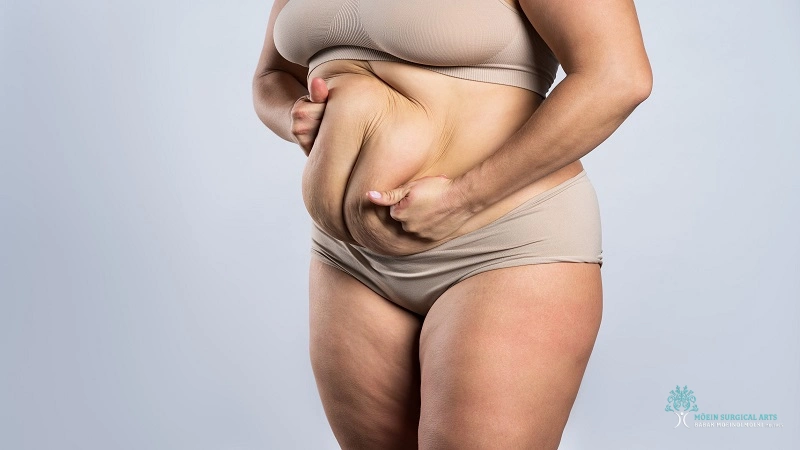
What Is a Fleur-de-Lis Tummy Tuck?
A Fleur-de-Lis Tummy Tuck (sometimes written “Fleur de Lis”) is an advanced form of extended tummy tuck designed to correct excess skin in two planes:
- Vertical excess (top to bottom)
- Horizontal excess (side to side, around the waist)
Where a standard tummy tuck in Los Angeles focuses mainly on the lower abdomen and central muscle tightening, the Fleur-de-Lis technique adds a vertical midline incision. This allows the surgeon to remove a “wedge” of excess skin from the center, tightening the waist and upper abdomen in a way that standard abdominoplasty cannot achieve.
Benefits of a Fleur-de-Lis Abdominoplasty
Despite its more extensive scars, many patients feel the benefits far outweigh the trade-offs, especially after massive weight loss.
Key advantages include:
- Dramatic skin removal: Targets central and lateral excess that hangs despite diet and exercise.
- Enhanced waistline definition: By tightening in two planes, the torso appears more hourglass or V-shaped, depending on body type.
- Improved comfort and hygiene: Reduced skin folds can mean fewer rashes, infections, and irritation.
- Clothing freedom: You can often wear fitted clothing, dresses, or swimwear without having to conceal folds of loose skin.
- Psychological and emotional benefits: Many patients describe feeling that their “outside finally matches how they feel inside” after their weight-loss journey.
For patients considering extended tummy tuck options or multi-area body contouring surgery, the Fleur-de-Lis pattern can be the centerpiece of a transformational plan.
Fleur-de-Lis Tummy Tuck vs. Regular

Below is a comparison of the Fleur-de-Lis Tummy Tuck and a Traditional Tummy tuck to help you understand which may be right for you.
| Feature | Fleur-de-Lis Tummy Tuck | Standard Tummy Tuck |
|---|---|---|
| Ideal Candidate | Massive weight loss patients with excess skin both vertically and horizontally | Patients with moderate skin laxity mainly in the lower abdomen |
| Incision Pattern | Horizontal bikini-line incision + vertical midline incision | Horizontal bikini-line incision only |
| Skin Removed | Removes skin in both vertical and horizontal directions; trims waist and central abdomen | Removes mostly lower abdominal skin and some upper abdominal laxity |
| Effect on Waistline | More powerful waist contouring, especially after bariatric surgery | Improves the lower abdomen; more modest waist shaping |
| Scarring | Low transverse scar + vertical scar from upper to lower abdomen | Single low transverse scar; usually hidden in underwear or swimwear |
| Commonly Combined With | Liposuction, breast lift, arm lift, thigh lift, panniculectomy | Liposuction of flanks, breast surgery, or BBL in selected cases |
| Typical Patient Goal | Remove large skin folds, improve hygiene, rashes, and achieve a dramatic, tightened abdomen | Flatten lower belly, refine abdominal contour, restore pre-pregnancy or pre-weight gain shape |
is all they need. For others, especially those who have lost 80–100+ pounds, the Fleur-de-Lis Tummy Tuck is the most effective of the extended tummy tuck options.
Who Is a Good Candidate for a Fleur-de-Lis Tummy Tuck?
Not everyone needs this more advanced technique. You may be a candidate if:
Significant Weight Loss
- You have undergone bariatric surgery (such as gastric sleeve or gastric bypass) or lost a large amount of weight through diet and exercise.
- You now have loose, draping skin that hangs in multiple directions, including over the waistband and through the central abdomen.
Skin Folds and Functional Problems
- You experience skin irritation, chafing, or rashes in the folds of your abdomen.
- Hygiene is more difficult due to overlapping skin.
- Clothing fits poorly, and you often “hide” your body in layered garments.
Stable Weight and Good Health
A qualified Los Angeles tummy tuck surgeon like Dr. Moein will also assess:
- Your weight stability (ideally stable for at least 6–12 months).
- Overall medical health (no uncontrolled diabetes, heart disease, or active smoking).
- Realistic expectations about scars, recovery, and final shape.
If you’re unsure whether you need a standard or Fleur-de-Lis approach, a personalized body contouring surgery consultation is the safest way to evaluate your options.
How the Fleur-de-Lis Tummy Tuck Surgery Works?
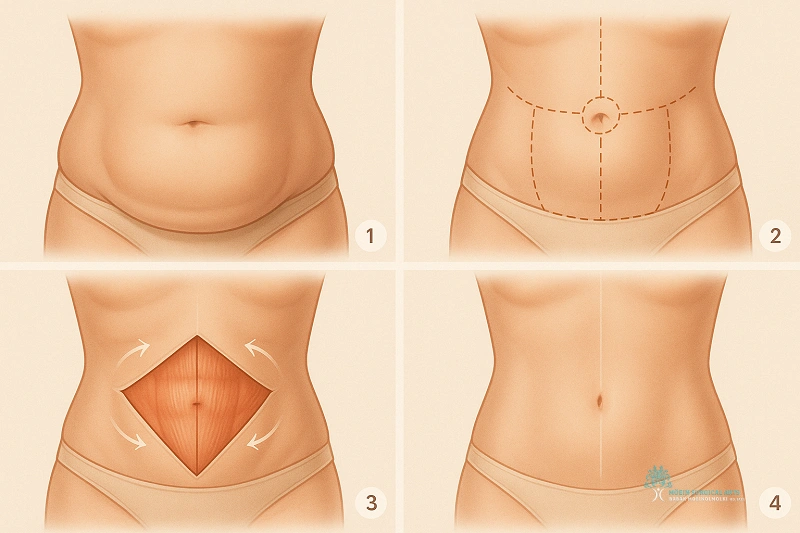
Consultation and Preoperative Planning
During your consultation, Dr. Moein:
- Reviews your weight-loss history, prior abdominal surgeries, and medical conditions.
- Examines skin quality, fat distribution, and muscle laxity.
- Discusses whether adding liposuction or other post-weight-loss procedures (such as arm, thigh, or breast surgery) is appropriate.
- Explains the expected scar pattern and shows tummy tuck before and after photos so you can visualize realistic results.
Anesthesia and Incisions
On the day of surgery:
- You are placed under general anesthesia for comfort and safety.
- A low horizontal incision is made along the lower abdomen, typically placed to be hidden in underwear or swimwear.
- A vertical incision is made along the midline of the abdomen, from just below the breastbone or mid-abdomen down to the lower incision.
The length and position of these incisions are customized to your anatomy and the degree of excess skin.
Muscle Repair and Skin Resection
- The abdominal skin and fat are carefully lifted to expose the rectus abdominis muscles.
- If needed, these muscles are tightened (plication) to correct separation (diastasis recti), creating a firmer abdominal wall.
- Excess skin is removed in both horizontal and vertical directions, allowing the surgeon to cinch in the waist and slim the entire torso.
Belly Button Positioning
In most cases, the belly button is preserved, but its opening on the skin is repositioned. Dr. Moein takes care to sculpt a natural-looking navel, which is crucial for a balanced aesthetic result.
Closure and Dressings
- Drains may be placed temporarily to remove fluid.
- Incisions are closed in multiple layers with meticulous suturing to support finer scar lines.
- A compression garment is applied to minimize swelling and support the new contour.
Recovery and Risks After Fleur-de-Lis Tummy Tuck
Recovery after a Fleur-de-Lis Tummy Tuck is usually slower than a standard tummy tuck because of the extra skin removal and two incisions. Most patients need 2–3 weeks before returning to light desk work and about 6–12 weeks before full activity, with final results maturing over 6–12 months.
Recovery at a glance:
- First 1–2 weeks: swelling, tightness, compression garment, short walks only
- Weeks 3–6: back to light work, standing more upright, no heavy lifting or core workouts
- Weeks 6–12: gradual return to exercise with surgeon’s clearance
- Long term: stable weight + scar care (silicone, sunscreen, massage) support lasting results
Like all surgery, a Fleur-de-Lis Tummy Tuck carries risks. These include bleeding, infection, delayed healing, fluid buildup, numbness, contour irregularities, and unfavorable scarring, sometimes requiring revision.
Key risk points:
- Bleeding, infection, or seroma (fluid collection)
- Slow healing where the incisions meet
- Numbness or changes in skin sensation
- Visible or widened scars, possible need for revision surgery
Working with an experienced Los Angeles tummy tuck surgeon who routinely performs post-weight-loss body contouring helps reduce these risks and supports a smoother recovery.
Cost Factors in Los Angeles for Fleur-de-Lis Tummy Tuck
The cost of a Fleur-de-Lis Tummy Tuck in Los Angeles is typically higher than a standard tummy tuck because it:
- Involves more complex skin resection and closure
- Often includes combination procedures such as liposuction or panniculectomy
Your total investment with a Los Angeles tummy tuck surgeon like Dr. Moein may include:
Any additional procedures (e.g., liposuction permanent fat removal, breast lift, arm lift)
Surgeon’s professional fee
Anesthesia fees
Accredited surgical facility costs
Postoperative garments and follow-up care
Because every patient’s anatomy, skin quality, and combination of procedures is different, pricing for a Fleur-de-Lis Tummy Tuck must be determined individually after a detailed in-person or virtual consultation. However, to help with general budgeting and expectations, most patients in Los Angeles fall into the approximate ranges shown below. These figures are estimates only and your final quote may be higher or lower depending on your specific surgical plan.
| Procedure | Typical Cost Range* |
|---|---|
| Standard Tummy Tuck (Los Angeles) | $12,000 – $18,000+ |
| Fleur-de-Lis Tummy Tuck (Los Angeles) | $16,000 – $25,000+ |
Ready to Explore Fleur-de-Lis Tummy Tuck with a Los Angeles Tummy Tuck Surgeon?
If you’ve worked hard to lose weight but are still living with heavy, hanging abdominal skin, you deserve to know all your options. A Fleur-de-Lis Tummy Tuck at Moein Surgical Arts may be the key to completing your transformation, restoring comfort and confidence, and giving you a body that genuinely feels like it belongs to the new you.
When you are ready to take the next step, book a consultation with Dr. Babak Moein. Together, you can design a customized surgical plan that honors your weight-loss achievement and helps you feel confident in your body again.
Why Patients Choose Dr. Babak Moein for Fleur-de-Lis Tummy Tuck?
Patients choose Dr. Moein because of:
- Dual expertise in bariatric and cosmetic surgery
- Experience with complex, post–weight-loss and multi-area contouring
- Ability to combine procedures safely (e.g., liposuction, panniculectomy, breast or arm lift)
- Proven results shown in tummy tuck before and after video. and photo
- Compassionate, education-focused care in an accredited Los Angeles surgery center
To learn whether this advanced post-weight-loss body contouring technique is right for you:
- Explore our main tummy tuck cost in california for more details.
- Discuss liposuction or other body contouring surgery options that can be combined with your procedure.
Contact Moein Surgical Arts at (310) 455-8020 to take the first step toward revealing your best self. Your new life awaits.
Frequently Asked Questions About Fleur-de-Lis Tummy Tuck?
1. How long do Fleur-de-Lis tummy tuck results last?
Results from a Fleur-de-Lis tummy tuck are considered permanent, provided you maintain a stable weight. The removed skin and fat won’t return, and the repaired muscles should remain tight. However, natural aging continues, and significant weight fluctuations can affect your results. Most patients enjoy their improved contours for decades with proper maintenance.
2. Can I combine a Fleur-de-Lis Tummy Tuck with liposuction?
to refine the flanks, back, or upper abdomen. During your consultation, Dr. Moein will determine how much liposuction can be safely done at the same time, depending on your goals and medical status.
3. Is the Fleur-de-Lis Tummy Tuck more painful than a standard tummy tuck?
Discomfort is typically similar or slightly increased, especially at the junction where vertical and horizontal incisions meet. However, modern anesthesia techniques, pain protocols, and careful postoperative management help keep pain controlled. Most patients describe tightness and soreness rather than sharp pain.
4. How much weight should I lose before Fleur-de-Lis Tummy Tuck?
You should be at or near your goal weight for at least 6-12 months before surgery. Most surgeons recommend being within 10-15 pounds of your ideal weight. Significant weight loss after surgery can create new skin laxity, while weight gain can stretch your results. Stable weight ensures optimal, lasting outcomes.
5. Can I get pregnant after a Fleur-de-Lis tummy tuck?
While pregnancy is possible after the procedure, it’s not recommended. Pregnancy will stretch the tightened skin and muscles, potentially reversing your surgical results. If you plan to have children, it’s best to wait until after completing your family. If unexpected pregnancy occurs, your results may be compromised, possibly requiring revision surgery.
6. When can I return to exercise after surgery?
Light walking begins immediately after surgery to prevent blood clots. Most patients can return to low-impact cardio like stationary cycling after 4 weeks. Full exercise clearance, including core work and weight training, typically comes at 8 weeks. Your surgeon will provide personalized guidelines based on your healing progress.
The condition impacts 68% of individuals who have excess weight loss of over 100 pounds and 92% of females who have undergone multiple Cesarean sections. Unlike regular fat deposits, which lie inside the abdominal cavity, apron belly is comprised of loose skin and subcutaneous fat that is unsupported and cannot be reduced by dieting and exercising.
Table of Contents
- Understanding the Grades of Apron Belly
- What Causes Apron Belly and Its Health Impact?
- Non-Surgical Treatment Options
- Surgical Solutions for Apron Belly
- Making the Right Choice: Which Procedure Is Best?
- Recovery and Results of Apron Belly Surgery
- Apron Belly FAQ
- Reclaim Your Confidence with Expert Apron Belly Treatment in Los Angeles
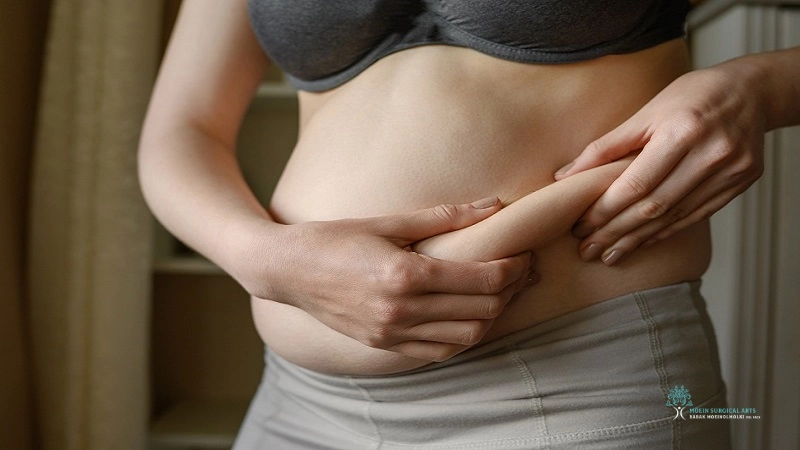
Understanding the Grades of Apron Belly
The severity ranges from Grade 1 (covering the pubic line) to Grade 5 (reaching below the knees), with each grade presenting unique challenges to the patient’s overall health. Although non-surgical treatments such as compression clothing can provide temporary benefits for patients, surgical options such as panniculectomy (commonly covered for patients with grades 3-5 pannus), abdominoplasty, or advanced liposuction are the only long-lasting methods for correcting and eliminating excess skin.
| Grade | Description | Coverage Area | Medical Issues | Insurance Coverage |
|---|---|---|---|---|
| Grade 1 | Mild overhang | Pubic hairline | Minimal | Rarely |
| Grade 2 | Moderate | Genital region | Hygiene issues | Sometimes |
| Grade 3 | Significant | Upper thigh | Infections, pain | Often |
| Grade 4 | Severe | Mid-thigh | Mobility problems | Usually |
| Grade 5 | Extreme | Knees or below | Severe restrictions | Always |
What Causes Apron Belly and Its Health Impact?

The apron belly (also called pannus) results from the accumulation of loose skin in the lower abdomen, often caused by pregnancy, rapid weight loss after bariatric surgery, aging, or fluctuating weight. When a woman gets pregnant, her abdominal walls are distended; therefore, her rectus muscles get separated due to childbirth in a condition termed diastasis recti. In most cases, this loose abdominal skin does not fully recover after childbirth. Additionally, after losing too much weight following bariatric surgery, the abdominal skin that was previously distended to hold excess fat fails to contract; as a result, there are folds of loose abdominal skin, termed an apron belly. Moreover, aging causes one to produce lower levels of collagen and elastin; consequently, one gets an apron belly that does not respond to even exercise and dieting due to the loss of elasticity caused by “yo-yo” dieting.
Apart from the appearance issue, other challenges come with an apron belly. Excess skin tends to retain moisture, leading to rashes, infections, and irritation. The heavy load on the abdominal area puts pressure on the hips, knees, and back. This results in pain due to strain. Some people are embarrassed to move about because of the difficulties that come with an apron belly.
Non-Surgical Treatment Options
- Compression Garments & Support Wear:
Medical-grade binders or garments (e.g., Marena, Leonisa) lift and support the pannus, easing back strain and reducing skin friction. They don’t remove excess skin but improve daily comfort and mobility. - Exercise & Core Strengthening:
Low-impact workouts like swimming, recumbent biking, or seated strength training build core muscles, improve posture, and decrease back pain. A stronger core also helps achieve better results if surgery is pursued later. - Skincare & Infection Prevention:
Keep the area under the apron clean and dry using antifungal powders and moisture-wicking fabrics. Regular inspection helps prevent rashes or infections. Consult a dermatologist if redness or odor develops. - Weight Stabilization:
Maintaining a steady weight for 6–12 months before surgery prevents further stretching of the skin and leads to safer, more predictable surgical outcomes.
Surgical Solutions for Apron Belly
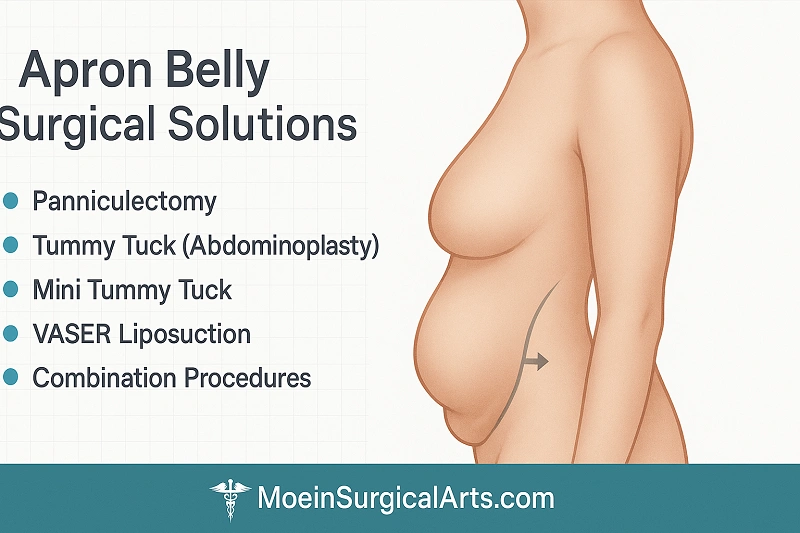
After examining thousands of patients with apron belly, Dr. Moein recommends these proven surgical approaches based on individual needs and goals:
Panniculectomy: The Medical Solution
Panniculectomy is the most direct solution for severe apron belly, specifically designed to remove the hanging panniculus. This procedure focuses purely on removing excess skin and fat for medical relief, not cosmetic enhancement. Research published by the National Institutes of Health shows that panniculectomy significantly improves quality-of-life scores.
During panniculectomy, Dr. Moein makes a horizontal incision from hip to hip, removes the entire apron of excess tissue (often 10-30+ pounds), and closes the remaining skin. Unlike cosmetic procedures, panniculectomy doesn’t tighten muscles or reposition the belly button; it simply removes the problematic overhang.
Best candidates include:
- Patients with Grade 3-5 apron belly causing documented medical problems
- Stable weight for at least 6-12 months
- Non-smokers or those willing to quit
- Realistic expectations about scarring
Panniculectomy Insurance coverage is possible when you have?
- Chronic infections documented by your doctor
- Skin breakdown or ulcerations
- Back pain limiting daily activities
- Failed conservative treatment for 3+ months
Recovery takes 4-6 weeks, with drains typically removed after 1-2 weeks. Most patients experience immediate relief from back pain and can walk more comfortably within days.
Check Panniculectomy Insurance Coverage →
Tummy Tuck (Abdominoplasty): Complete Abdominal Rejuvenation
While panniculectomy removes excess skin, a tummy tuck goes further by tightening muscles and contouring your entire midsection, improving both function and aesthetics. According to the American Society of Cosmetic Surgeons, tummy tuck procedures have a 98% satisfaction rate among patients.
The procedure involves removing excess skin and fat, tightening separated abdominal muscles (repairing diastasis recti), repositioning the belly button, and creating a flatter, more toned appearance. Dr. Moein uses advanced techniques to minimize scarring and create natural-looking results.
Why patients choose tummy tuck over panniculectomy?
- Repairs muscle separation from pregnancy
- Creates an hourglass silhouette
- Includes liposuction for better contouring
- More dramatic aesthetic results
- Higher satisfaction rates (98% vs 85%)
The investment ranges from $12,000-$20,000, but many patients find the comprehensive results worth the additional cost over panniculectomy alone.
Panniculectomy vs Tummy Tuck: Which is Right? →
Mini Tummy Tuck: The Targeted Approach
For patients with mild to moderate apron belly limited to below the navel, a mini tummy tuck offers excellent results with less downtime.
This procedure uses a shorter incision (similar to a C-section scar) and focuses on the lower abdomen only. Dr. Moein can still repair muscle separation in the lower region and remove excess skin, but recovery is just 2-3 weeks compared to 6-8 weeks for a full tummy tuck.
Best for Grade 1-2 apron belly where the upper abdomen has good tone but the lower belly needs attention. Ideal candidates often include women with a post-pregnancy “pooch” that won’t respond to exercise.
Liposuction Solutions: Advanced Fat Sculpting Techniques
While traditional liposuction has limitations for apron belly, Dr. Moein’s advanced techniques can achieve remarkable results in the right candidates.
Traditional Liposuction: Best for patients with fatty apron and good skin elasticity. Removes up to 5 liters of fat but cannot address excess skin. If your skin is already loose, liposuction alone may worsen the appearance.
Explore Liposuction Cost in Los Angeles→
VASER Hi-Definition Liposuction: Using ultrasound technology, VASER breaks down fat cells while preserving connective tissue, resulting in 30-40% skin retraction, significantly better than traditional lipo. The ultrasound energy stimulates collagen production, promoting natural skin tightening over 3-6 months.
Perfect for Grade 1-2 apron belly in patients who want to avoid major surgery. VASER can address fibrous fat that traditional liposuction cannot remove effectively.
HD Lipo (4D Sculpting): Our signature HD Lipo combines VASER with artistic sculpting to not just remove your apron, but create an athletic, toned appearance. Dr. Moein etches natural muscle definition, creating shadows and highlights that mimic a fit physique.
This advanced technique works on both deep and superficial fat layers, transforming a “dad bod” into a more athletic build. Dr. Moein is one of only 50 surgeons nationally certified in these advanced HD sculpting techniques.
The Ultimate Solution: Combination Procedures
Why 87% of our apron belly patients choose combination treatments for optimal results:
Tummy Tuck + HD Lipo (Most Popular): The gold standard for complete transformation. The tummy tuck removes excess skin and tightens muscles while HD Lipo sculpts surrounding areas (flanks, back, pubic area) for seamless, natural contours. One surgery provides complete transformation, with patients averaging 4-6 clothing sizes smaller.
Panniculectomy + VASER (Insurance Friendly): Strategic approach for insurance coverage. Panniculectomy is often covered by insurance while adding VASER for aesthetic enhancement (self-pay). Total out-of-pocket often less than tummy tuck alone.
Mini Tummy Tuck + HD Lipo (Minimal Downtime): Perfect for mild apron belly. Addresses lower belly pooch while HD Lipo defines entire torso. Back to work in 10-14 days.
Making the Right Choice: Which Procedure Is Best?
Choosing the right procedure depends on multiple factors including your apron belly grade, skin quality, muscle condition, budget, and personal goals. During your consultation, Dr. Moein evaluates these factors to recommend the most appropriate approach.
| Procedure | Best For | Recovery | Skin Removed | Muscle Repair | Cost Range |
|---|---|---|---|---|---|
| Panniculectomy | Medical issues | 4–6 weeks | 10–30+ lbs | No | $8,000–15,000* |
| Full Tummy Tuck | Complete transformation | 6–8 weeks | 5–15 lbs | Yes | $12,000–20,000 |
| Mini Tummy Tuck | Lower belly only | 2–3 weeks | 2–5 lbs | Partial | $7,000–12,000 |
| VASER Lipo | Good skin elasticity | 1–2 weeks | Fat only | No | $10,000–15,000 |
| Combo Procedures | Maximum results | 6–8 weeks | Varies | Yes | $18,000–25,000 |
Recovery and Results of Apron Belly Surgery
Recovery varies by procedure but follows similar patterns:
Week 1-2: Rest period with drains, pain management, and limited movement. Most patients are surprised that discomfort is less than expected.
Week 3-4: Gradual return to light activities, walking encouraged. Swelling begins to decrease.
Week 6-8: Return to exercise and normal activities. Final results continue developing.
Month 3-6: Final results emerge as swelling completely resolves and scars begin to fade.
Apron Belly FAQ
Will I have visible scars? Yes, all apron belly surgeries leave scars, but they’re placed low and can be hidden by underwear or swimwear. Scars fade significantly over 12-18 months with proper care.
Can the apron belly come back? If you maintain stable weight, results are permanent. However, significant weight gain or pregnancy can stretch the skin again.
What if I want more children? It’s best to wait until after completing your family. Though having children after surgery is safe, it may just affect your results.
How much weight will I lose from surgery? The removed tissue typically weighs 5-30 pounds, but this varies greatly. Remember, this is body contouring, not weight loss surgery.
Reclaim Your Confidence with Expert Apron Belly Treatment in Los Angeles
Living with an apron belly can impact every part of your life, from your health and mobility to your self-confidence. You don’t have to continue enduring discomfort, infections, or daily limitations.
At Moein Surgical Arts in Los Angeles, Dr. Babak Moein, a board-certified cosmetic and weight loss surgeon with over 20 years of experience, has helped thousands of patients restore their bodies and confidence through advanced body contouring procedures. Using the latest surgical techniques and a personalized approach, Dr. Moein delivers safe, natural, and life-changing results.
Discover why patients throughout Los Angeles trust Dr. Moein for their transformation.
Explore his credentials, read patient testimonials, or schedule your consultation today.
 Call Now: 310-455-8020 to speak with our team and take the first step toward feeling confident in your body again.
Call Now: 310-455-8020 to speak with our team and take the first step toward feeling confident in your body again.
Liposuction costs can range anywhere from $5,000 to well over $20,000—but why such a vast difference? The answer lies in the procedure. Not all liposuction is equal, and the type of technology your surgeon uses plays a significant role in determining your final bill. Traditional tumescent liposuction can range from $ 2,000 to $5,000 per area, while newer technologies, such as VASER (ultrasound) or SmartLipo (laser), can range from $5,000 to $10,000 or more for the same area. The American Society of Cosmetic Surgeons has estimated the average cost of a liposuction procedure to be $4,711; however, this does not account for anesthesia fees, facility fees, or the specific method used. Here, we will compare the price differences among some of the most popular liposuction treatments—tumescent, laser liposuction, ultrasound-assisted liposuction, power-assisted liposuction, and more—so that you can better understand the reasons behind the price differences and make an informed decision about which approach is the most cost-effective for your body contouring goals.
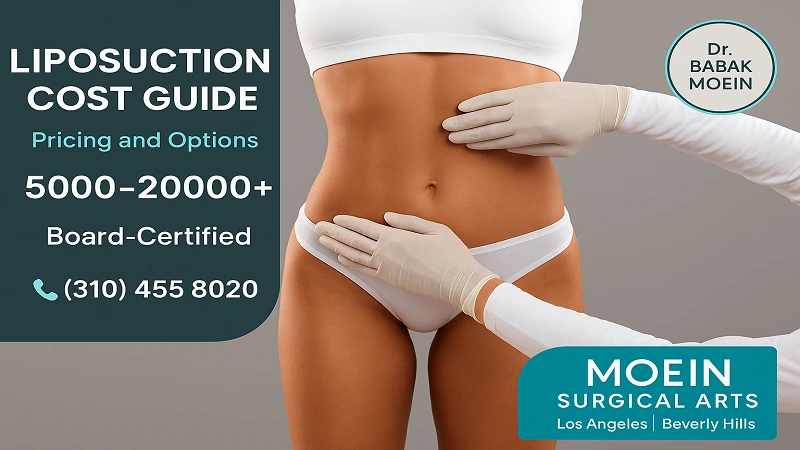
What Affects the Cost of Liposuction?
Your final liposuction bill isn’t one flat rate—several key factors shape it:
- Number of treatment areas – One zone vs. multiple areas in a single session
- Surgeon’s experience and credentials – Board certification and years of specialized training
- Technique used – Traditional, laser-assisted, VASER, or high-definition sculpting
- Geographic location – Urban centers cost more than smaller cities
- Anesthesia type – Local vs. general anesthesia
- Facility fees – Accredited surgical center vs. hospital operating room
- Case complexity – Your skin quality, previous surgeries, and overall health
- Additional procedures – Combining lipo with tummy tuck, BBL, or body contouring
We’ll break down each of these in detail below, including real price ranges and what you’re actually getting for your money.
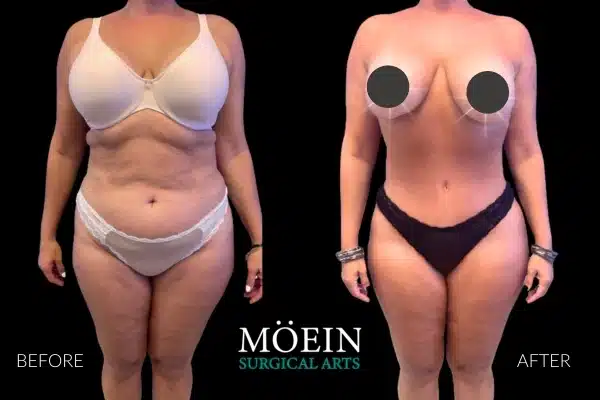
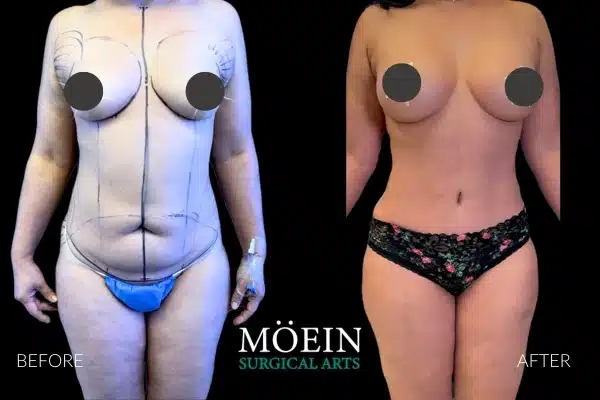
Liposuction Techniques Cost Comparison
The most significant determining factor for your liposuction expense is the method your surgeon selects. Although time-tested traditional tumescent liposuction has been the standard for many years, newer technologies, such as laser-assisted, VASER, and high-definition sculpting, bring their own advantages, including quicker turnaround times and more pronounced muscle definition. The caveat? The caveat is that advancements in techniques generally translate into pricier expenses. Here, we’ve compared the most prevalent methods of liposuction against one another, so you know exactly what you’re paying for:
| Technique | Cost Range | Recovery Time | Best For | Technology |
|---|---|---|---|---|
Traditional/Tumescent Budget-Friendly | $2,000 – $5,000 | 1-2 weeks | Larger fat volumes, multiple areas, proven results | Manual suction with tumescent solution |
Mini Liposuction Most Affordable | $1,500 – $4,000 | 3-7 days | Small, localized areas (chin, knees, arms) | Local anesthesia, minimal invasiveness |
Laser-Assisted (SmartLipo) Popular Choice | $3,000 – $7,500 | 1-2 weeks | Skin tightening, smaller areas, faster healing | Laser fiber melts fat + tightens skin |
Power-Assisted (PAL) Efficient | $3,500 – $8,000 | 1-2 weeks | Dense fat, multiple areas, even results | Motorized vibrating cannula |
Ultrasound-Assisted (UAL) Advanced | $4,000 – $9,000 | 1-3 weeks | Fibrous areas (back, male chest), revision cases | Ultrasonic waves liquefy fat cells |
VASER Liposuction Premium | $4,500 – $10,000 | 1-2 weeks | Precision contouring, less bruising, smooth results | Advanced ultrasound, tissue-selective |
High-Definition (HD Lipo) Elite Option | $8,000 – $20,000+ | 2-4 weeks | Athletic definition, visible abs, muscle sculpting | VASER + artistic muscle etching |
Here’s how the popular options stack up side-by-side when it comes to results, recovery, and real-world outcomes.
How Surgeon Experience Affects Liposuction Cost in Los Angeles?
Get real, you’ll see surgeons quoting $3,000 and some quoting $12,000 for procedures of the same kind. Why? Experience, credentials, and know-how. A board-certified cosmetic surgeon who has undergone extensive specialty training is likely to charge more because they can achieve a natural look, minimize complications, and provide a lasting result. Making your decision based solely on cost may result in poor outcomes, necessitating repairs or even severe complications that require a significant financial investment to rectify.
At Moein Surgical Arts, you are treated by Dr. Babak Moein, a board-certified cosmetic surgeon with more than 20 years of experience in state-of-the-art body contouring. He is known across Los Angeles and Beverly Hills for being precise, safe, and having performed thousands of successful makeovers.
Average Liposuction Cost by Area – Abdomen, Thighs, Chin & More
Now that you understand the techniques, let’s discuss what you’ll actually pay, based on where you want to receive treatment. Some areas are quick and straightforward, while others require more time, skill, and precision, which naturally affects the price. Here’s what you can expect to invest in for the most commonly treated areas.
| Body Area | Cost Range | Procedure Time | Typical Volume | Often Combined With |
|---|---|---|---|---|
| Abdomen (Upper/Lower) Most Popular | $3,500 – $8,000 | 2-3 hours | 2-4 liters | Flanks, waist |
| Flanks (Love Handles) Popular | $2,500 – $6,000 | 1-2 hours | 1-2 liters | Abdomen, back |
| Thighs (Inner & Outer) | $3,000 – $7,500 | 2-3 hours | 2-3 liters | Hips, knees |
| Upper Arms | $2,500 – $5,500 | 1-2 hours | 0.5-1 liter | Back, bra line |
| Back & Bra Line | $3,000 – $6,500 | 1.5-2.5 hours | 1-2 liters | Flanks, arms |
| Buttocks | $3,000 – $7,000 | 2-3 hours | 1-3 liters | BBL, thighs |
| Hips (Saddle Bags) | $2,500 – $6,000 | 1.5-2 hours | 1-2 liters | Thighs, flanks |
| Male Chest (Gynecomastia) | $4,000 – $8,000 | 2-3 hours | Varies | Gland removal |
| Chin & Neck (Submental) Popular | $2,000 – $4,500 | 1 hour | 0.2-0.5 liters | Neck lift, facelift |
| Knees (Inner) | $1,800 – $4,000 | 1 hour | 0.3-0.5 liters | Thighs, calves |
| Ankles & Calves | $2,500 – $5,500 | 1.5-2 hours | 0.5-1 liter | Knees, thighs |
| 360-Degree Lipo (Full Torso) Package Deal | $8,000 – $18,000 | 3-5 hours | 4-8 liters | Complete transformation |
What is the cost of liposuction near me?
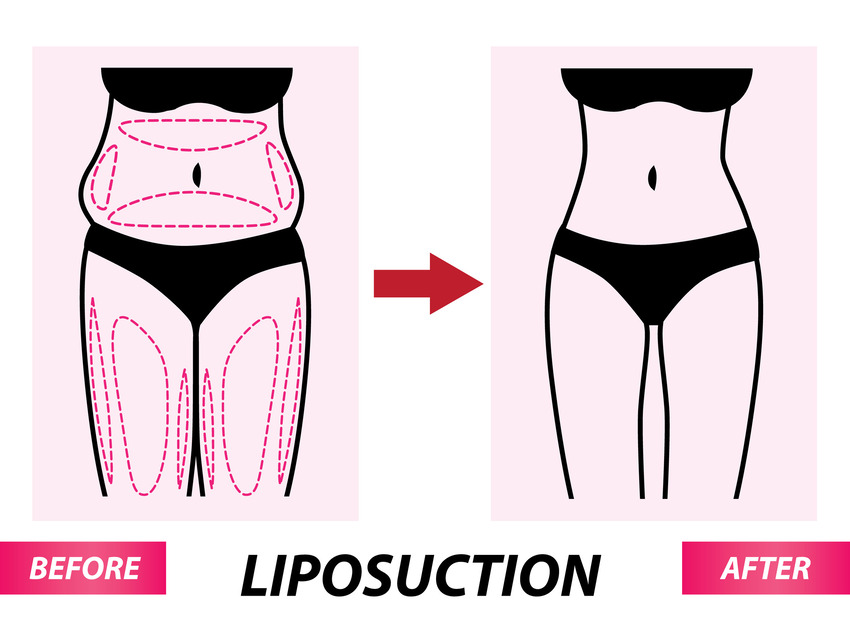
Where you get your liposuction significantly impacts the cost. Procedures in Los Angeles, Beverly Hills, or Manhattan cost more than in smaller cities, not because of the quality, but due to overhead. Rent, staff salaries, and facility costs are higher in major metropolitan areas, and these expenses are ultimately passed on to patients.
However, higher prices in cities like LA often mean access to top-tier surgeons and advanced facilities. At Moein Surgical Arts in Los Angeles, you’re investing in both a premium location and Dr. Moein’s decades of expertise. Choosing surgery based solely on finding the cheapest city can backfire; complications far from home mean limited follow-up care and unfamiliar standards.
| California Region | Typical Liposuction Cost |
|---|---|
| Liposuction Cost Los Angeles | $6,000 – $20,000 |
| Liposuction Cost Beverly Hills | $6,500 – $21,000 |
| Liposuction Cost Orange County | $5,500 – $20,500 |
| Liposuction Cost San Diego | $5,000 – $22,000 |
| Liposuction Cost Inland Empire | $5,000 – $19,000 |
| Liposuction Cost Central Valley | $5,500 – $19,500 |
Awake Liposuction vs. General Anesthesia: How to Decide What’s Right for You
When you choose to have your liposuction awake or with general anesthesia, there are some significant factors that need to be addressed. Your comfort, the amount of locations that you’ll need treated, and your surgical objectives all contribute to finding the optimal choice.
Number of Treatment Areas
- If you want more than a few regions treated, usually more than three, it is generally best to have the procedure conducted under general anesthesia.
- This procedure enables you to achieve more accuracy and efficiency in surgery, but in a manner that you remain comfortable all along.
Anxiety, PTSD, and Medical Conditions
Patients with major anxieties, histories of PTSD, or medical issues that would make them not relaxed or cooperative for surgery should consider having their procedure performed under anesthesia.
These factors can influence your potential to sit still as well as comfortably during awake liposuction.
Cost Considerations
It is one of the benefits of awake liposuction that it is more economical. Not costing as much as a surgery center, anesthesiologist, or specialty nurses, awake procedures have lower overhead. For patients on a lower budget or those having only a small area treated, this can be an appealing option.
High-Definition (HD) Liposuction
If you want high-def or 360° body sculpting, we highly suggest going through general anesthesia.
It involves the application of VASER technology for the removal of fat near the skin or fascia with great accuracy. It involves more pressure and manipulation, hence it is not comfortable when carried out by local anesthesia. Therefore, for high-def liposuction, the patient experiences a more comfortable, effective, and controlled procedure with general anesthesia.
Skin Tightening Procedures
Skin tightening surgeries such as Renuvion (J-Plasma) also do better with general anesthesia. The Renuvion shrinks the skin by means of regulated heat energy, and such heat would most definitely induce discomfort among patients who are awake. Under anesthesia, it is more thoroughly and skillfully carried out by the surgeon.
Fat Grafting and Structural Work
When performing fat grafting into deeper structures (for example, the buttocks, chest, or face), it’s safest and most effective to do so under anesthesia. This permits the exact placement of fat and for patient ease, with no constraint that is associated with being awake.
Summary: Who Is a Good Candidate for Awake Liposuction?
Awake liposuction is a good option for patients who:
Are on a limited budget
Wish to treat one to three small areas
Have minimal anxiety
Are in good overall health
For patients seeking more extensive body contouring, high-definition results, or skin tightening with Renuvion, general anesthesia remains the preferred and safest approach.
Mini Lipo
Traditional Lipo
VASER Lipo
HD Lipo
Does Insurance Cover Liposuction in Los Angeles?
Almost never. Insurance treats liposuction as cosmetic, meaning you pay out of pocket. The rare exception: medically necessary cases like lipoma removal or severe gynecomastia causing physical pain. You’ll need extensive documentation, so don’t count on it.
Your Payment Options
Good news, you don’t need the full amount upfront. Most practices offer financing that spreads payments over months or years. Compare your options below and choose what works for your budget.
Smart Money Tips:
- Ask for total out-the-door pricing (no surprises)
- Look for package deals when treating multiple areas
- Inquire about seasonal promotions
- Consider year-end timing if you have expiring FSA funds
At Moein Surgical Arts, we work with you to find a payment plan that suits your needs. Cost shouldn’t stop you from feeling confident in your body.
| Financing Option | Typical Rates/Terms | Best For | Watch Out For |
|---|---|---|---|
| Cherry | 0% interest options, flexible monthly payments | Fast approval, no hard credit check, pay over time | Shorter terms for some applicants |
| CareCredit | 0% for 6-24 months, then 26%+ APR | Quick approval, widely accepted | High interest after promo period |
| Prosper Healthcare | 7.95-35.99% APR, up to $35,000 | Fixed rates, predictable payments | Rates vary by creditworthiness |
| In-House Payment Plans | Low/no interest, 3-12 months | No credit check often required | Shorter terms, limited availability |
| Personal Bank Loan | 6-20% APR depending on credit | May offer better rates if credit is excellent | Harder approval process |
| 0% Intro APR Credit Card | 0% for 12-21 months, then 18-25% | No interest if paid off in time | Must pay off before promo ends |
Hidden Costs You Need to Know About
That price quote your surgeon gives you? It’s not the whole story. Here are the extras that can catch you off guard:
Facility Fees: $800-$2,500 for surgical center use (hospitals cost even more)
Anesthesia: Already covered this, but it’s billed separately—don’t forget it
Pre-Op Testing: $200-$500 for bloodwork and health screening
Compression Garments: $100-$400 total (you’ll need 2-3 quality garments)
Medications: $50-$200 for pain meds, antibiotics, and anti-nausea prescriptions
Follow-Up Visits: Usually included, but extra appointments may cost more
Potential Revisions: Touch-ups can cost 50-100% of the original procedure if needed
Time Off Work: Factor in lost wages during your 3-14 day recovery
The Bottom Line: Add 20-30% to your surgeon’s quote to cover these extras. At Moein Surgical Arts, we provide transparent, all-inclusive pricing upfront so you’re never blindsided by surprise bills. Ask for your total out-the-door cost during consultation.
Liposuction Cost Estimator
This calculator lets you estimate an approximate cost of your liposuction before you set a consultation appointment. The calculator considers major factors such as locations you want treated, kind of anesthesia (awake or general), and procedure complexity. This calculator is only an approximate guide, and your real quote is going to be exclusively for you after a proper check-up with Dr. Babak Moein from our clinic in Los Angeles.
BMI: 0
Price of surgery: $0
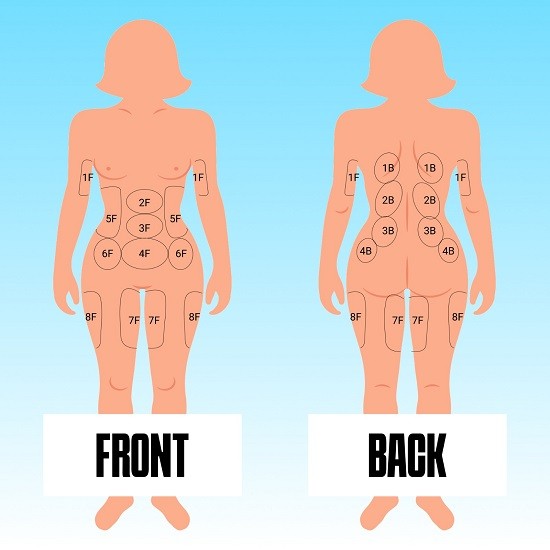
Body Contouring Services at Moein Surgical Arts in Los Angeles
Beyond standard liposuction, Dr. Moein offers specialized procedures for dramatic transformations:
Ab Etching: VASER or HD lipo carves visible six-pack definition by sculpting fat around your abdominal muscles. Best for lean patients with good muscle tone. Cost: $6,000-$12,000.
360-Degree Lipo: Complete torso makeover in one session—abdomen, flanks, back, and waist. Package pricing saves 20-30% versus treating areas separately. Cost: $8,000-$18,000.
Tummy Tuck + Lipo: Removes excess skin, tightens muscles, and eliminates stubborn fat. Perfect after pregnancy or weight loss when skin elasticity is compromised.
Brazilian Butt Lift + Lipo: Harvest fat from problem areas and transfer it to create rounder, lifted curves. Slim your waist while enhancing your buttocks—two goals, one recovery.
Combining procedures saves thousands on anesthesia and facility fees while cutting recovery time in half. Ask about package deals during your consultation.
And wondering how chain clinics like Sono Bello compare to private-practice liposuction with Dr. Moein? Please read our complete guide on Sono Bello cost in Los Angeles.
Why Choose Dr. Babak Moein for Your Liposuction in Los Angeles?
At Moein Surgical Arts, you’re not just another procedure. Dr. Moein is a board-certified cosmetic and general surgeon with over 20 years of specialized experience in body contouring and advanced liposuction techniques. His reputation throughout Los Angeles and Beverly Hills is built on:
- Board-certified by the American Board of Cosmetic Surgery – the gold standard
- 20+ years specializing in body contouring – VASER, HD lipo, and advanced techniques
- Thousands of successful transformations across Southern California
- Artistic precision – Results that look natural, never overdone
- Accredited surgical facility with the highest safety standards
- Transparent, all-inclusive pricing – No hidden fees or surprise bills
What Our Patients Say
Don’t just take our word for it. Hear from real patients who’ve transformed their bodies at Moein Surgical Arts. Read patient testimonials and see before/after results →
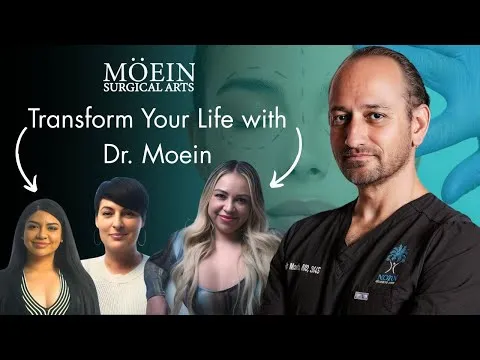
Schedule Your Liposuction Consultation in Los Angeles
Get transparent pricing, expert guidance, and a personalized treatment plan from Dr. Moein
The “snatched waist” refers to far more than just a trendy term with respect to the world of style; it represents a strong silhouette that can fully revolutionize the manner in which garments drape on your frame, the way that photos look, and greatly impacts the manner in which you perceive yourself in your own skin. Instagram celebrities have amplified the desirability of the hourglass waist, turning a narrow, well-defined midsection into a dominant beauty ideal that drives fashion and body-contouring trends; At Moein Surgical Arts, situated in the dynamic city of Los Angeles, we make it our mission to help individuals thoroughly understand the realistic avenues that can be taken towards realizing a slimmer and more defined midsection:
this can vary anywhere from adherence to restrictive nutrition and strength training to undergoing specific body-contouring surgeries such as liposuction, high-def lipo, and abdominoplasty. This complete guide exists to shed light on exactly what pays off, what doesn’t, as well as tips on choosing a safe and customized program that perfectly corresponds with your specific anatomy, as well as personal objectives.

Why a “Snatched Waist” Is More Than a Trend (What Patients Mean)
When the patient says they want their waist snatched, they want their waist to look narrow and proportionate, not just when they wear all sorts of outfits, but also when portrayed on camera. That means:
The reduction of the fullness found in the flank area and the lower abdomen leads to a noticeable softening of the waistline, creating a more refined appearance overall.
Seamless and fluid transitions from the waist area down to the hip region, ensuring there are no unsightly bulges or rolls present.
Contour definition around the obliques or waist sulcus for the athlete’s edge.
An outline or shape that looks very normal has an appearance of balance, as well as being proportionate in comparison to the patient’s individual skeletal outline.
Common Body Shapes & What They Mean for a “Snatched Waist”
<Understanding your body shape is the first step toward a realistic, satisfying pathway to a snatched waist. V-shaped (inverted triangle) and A-shaped (pear) frames naturally influence how a narrowed waist will read—V-shapes often benefit most from targeted flank reduction and HD-lipo, while A-shapes can achieve dramatic waist-to-hip improvements by combining flank liposuction with subtle fat grafting to the hips. By contrast, Round (apple) shapes usually require medical weight management and staged contouring because central/visceral fat limits immediate surgical narrowing, and Square (rectangle) frames often need both subtraction (liposuction) and addition (fat grafting) to create a convincing hourglass curve.
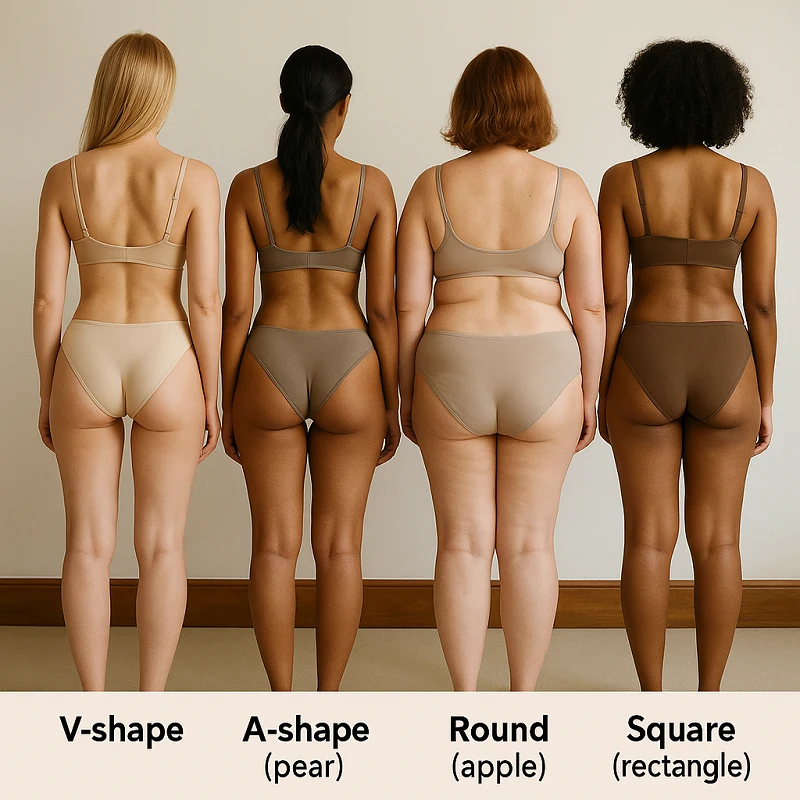
| Body Type | Key Features | Recommended Approach | Chance Of Top Result |
|---|---|---|---|
| V-Shape (Inverted Triangle) | Broad shoulders, narrow hips; often good skin tone | Targeted liposuction / HD-lipo for oblique definition | 85% |
| A-Shape (Pear) | Narrow shoulders, wider hips; natural lateral fullness | Flank liposuction + optional fat grafting to hips/BBL | 80% |
| Round (Apple) | Central/visceral fat predominance; possible skin stretch | Medical weight management first; staged liposuction/abdominoplasty later | 45% → 75%* |
| Square (Rectangle) | Straight silhouette with similar shoulder/hip width | Liposuction + strategic fat grafting to hips/buttocks; posture work | 60% |
*Round (Apple) type: initial chance reflects pre-optimization; chance improves significantly after sustained weight loss and staged contouring.
Liposuction For A Snatched Waist: Techniques & When To Use Each
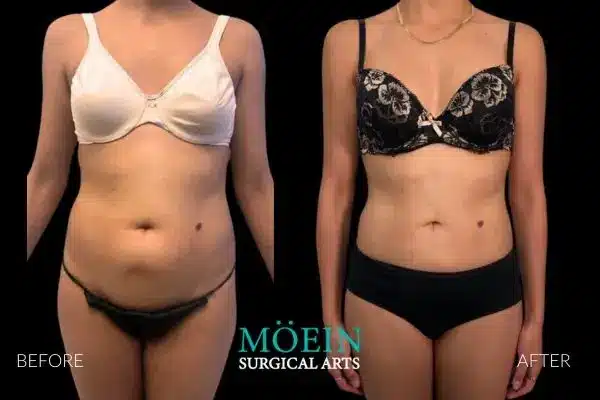
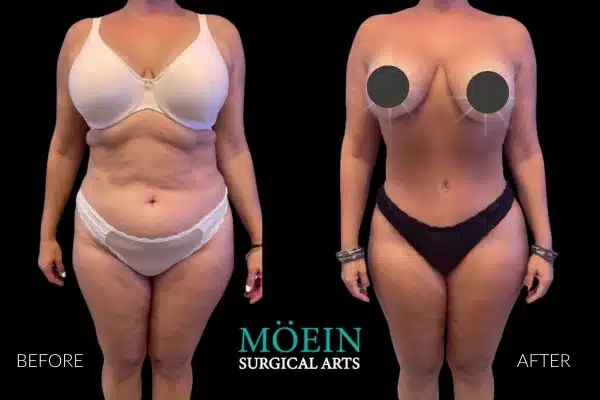
flank, abdomen below the waist, and lower abdomen through small incisions. The choice of technique varies according to the nature of the tissue as well as the sculpting desired.
- Tumescent Liposuction: The basic procedure. Bleeding is minimized by tumescent fluid, which also achieves local anesthesia; the surgeon resculptures the fat using small incisions. Most suitable for the predictable removal of the fat for quick operative recovery.
- Power-Assisted Liposuction (PAL): Uses an electric motor on a stereoscopic surgical set. It improves the surgeon’s dexterity for large volumes or for fibrous areas.
- Ultrasound-Assisted (VASER) Liposuction: Ultrasonic energy helps break the fat down beforehand, before it’s suctioned out, useful in denser tissue as well as for definition on the obliques, Where subtle contouring is crucial.
- Combination Approaches: Many patients benefit greatly from an individually tailored combination of techniques, precisely PAL and VASER, in an effort to achieve ultra-smooth and high-def outcomes that adhere to their personal aesthetic objectives.
Power-Assisted & Ultrasound-Assisted Liposuction (PAL, VASER) — Benefits and Indications
PAL and VASER each have advantages:
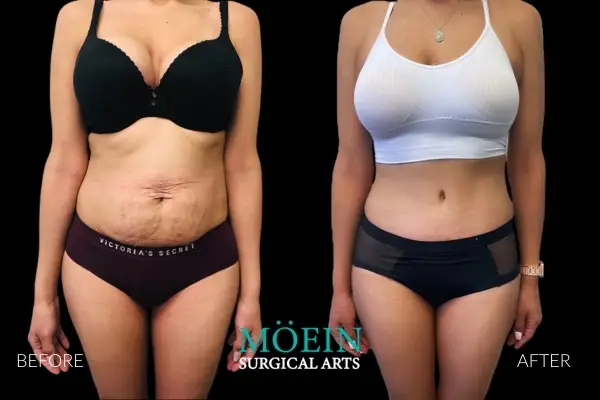
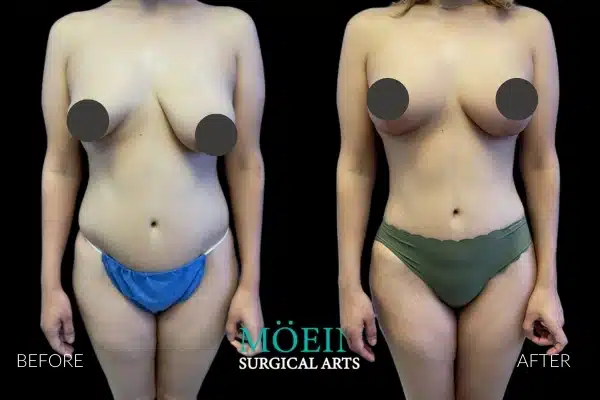
- PAL speeds fat removal in larger areas and improves surgeon control.
- VASER aids in finer sculpting and can facilitate skin retraction when subtle skin tightening is needed.
Indications favor PAL for broad flank reduction and VASER when high definition and muscle delineation are primary goals. Proper patient selection and technique are essential to avoid irregularities.
High-Definition (HD) Liposuction — Carving Obliques And Waist Definition
HD-lipo is an additional sculptural version of liposuction that sculpts the superficial as well as deeper layers of fat to outline muscular contours, obliques, lines on the upper abdomen, as well as an increased indentation at the waist. HD methods require the expertise of an experienced surgeon as well as precise postoperative treatment (compression, massage for the lymphatic system) to provide consistent, bilateral outcomes.
HD-lipo is best suited for sporty patients who already have a small percentage of body fat or who are entirely committed to the retention of their muscle bulk. It should not be emphasized too much as an alternative to overall obesity reduction programs.
Enhancing Curves with Fat Grafting (BBL) — Improving Waist-to-Hip Ratio
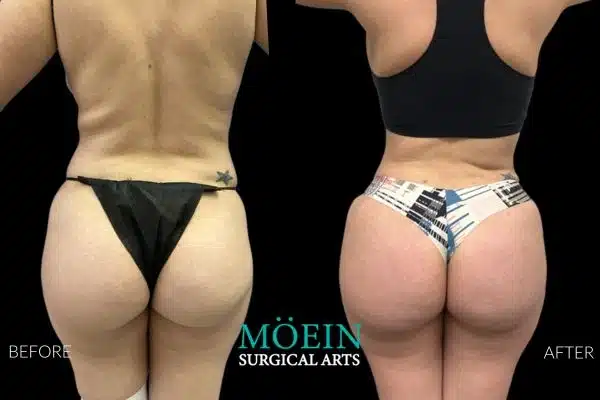

Brazilian Butt Lift (autologous fat grafting to the hips and buttocks) is a powerful complement to waist contouring. By harvesting fat from the waist and flanks and transferring it to the hips or upper buttock, we can accentuate lateral fullness so the waist appears narrower and more sculpted. Ideal candidates have adequate donor fat, stable weight, and realistic goals. As with any fat-grafting procedure, safety depends on technique and experience; we perform grafting strictly in the subcutaneous plane and in accredited settings to maximize graft survival and minimize risk.
Abdominoplasty (Tummy Tuck) And Waistline Reshaping — When Skin Tightening Is Required
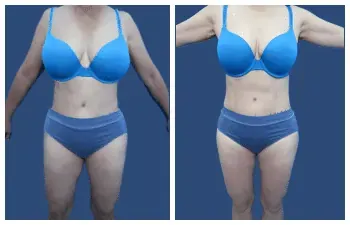

When skin redundancy, stretch marks, or rectus diastasis are present, abdominoplasty provides structural correction that liposuction alone cannot. A full tummy tuck removes excess skin and repairs the abdominal wall, tightening the waist circumference and restoring a flat lower abdomen.
- Mini Tummy Tuck: Limited skin excision for infra-umbilical laxity.
- Full Abdominoplasty: Comprehensive skin and muscle tightening, ideal after pregnancy or substantial weight loss.
- Extended or Fleur-De-Lys Variants: Reserved for significant excess and complex contour needs.
Combining abdominoplasty with liposuction of the flanks is common, the result is a refined waist with improved skin quality and reinforced abdominal support.
Renuvion (Helium Plasma) For Skin Tightening — When Less-Invasive Contraction Helps
Renuvion (helium-plasma–assisted RF tightening) can be a valuable adjunct to liposuction for patients with mild-to-moderate skin laxity. By delivering controlled energy beneath the skin, Renuvion promotes immediate contraction and longer-term remodeling, improving abdomen and flank skin quality and helping the waistline appear smoother without large excisions. It is not a replacement for abdominoplasty in patients with significant excess skin, but in properly selected patients it reduces the need for more extensive procedures.
Combining Procedures: Liposuction + Fat Grafting For An Hourglass Silhouette
Creating an ideal waist is not only subtraction, sometimes adding strategic volume enhances proportions. Fat grafting to the hips or buttocks while removing flank fat increases the waist-to-hip ratio and produces a natural hourglass contour.
This combined approach requires judicious planning:
- Harvested fat is refined and grafted to specific points in the hip or posterior pelvis to accentuate curves.
- Simultaneous liposuction sculpts the waistline.
- Results depend on graft survival and contour harmony; the best outcomes come from surgeons experienced in both liposuction and fat transfer.
At Moein Surgical Arts we emphasize proportional, subtle augmentation rather than exaggerated changes.
What To Expect — Recovery Timeline After Waist-Contouring Surgery
The recovery hinges on the extent of the procedure but follows the below normal expectations in most cases:
- Days 1–7: Mild swelling and local tenderness managed by oral medication, early ambulation enforced.
- Weeks 1–3: Most patients resume office work on a part-time basis;; compression garments are worn continuously.
- Weeks 4–6: There will be slow, gradual resumption of exercise as authorized and cleared by the surgeon; in the interim, it should be emphasized that swelling decreases progressively.
- 3–6 months: Contours of final shape become clear as final swelling resolves.
We provide an individualized recovery program, well-defined goals, and direct access to the care staff throughout the recovery period.
Realistic Results: How Bone Structure, Skin Elasticity, And Genetics Limit Outcomes
Contouring surgery shows but doesn’t redo the underlying anatomy. Those who have narrow pelvises or small rib cages naturally might realize a more extreme definition at the waist compared to those who have larger skeletal structures. Elasticity of the skin plays a role: younger patients or those who tend to hold their skin well realize leaner outcomes through liposuction alone; those who have saggy skin respond best to abdominoplasty.
Having realistic expectations is also important for patients to achieve high satisfaction levels. Dr. Babak Moein takes the time to carefully go through before and after photos of patients who share the same anatomical features, so you may perceive the possible results that you will expect.
Financing, Cost Drivers, And How We Provide Transparent Pricing For Waist Contouring
Procedure cost depends on:
- Number and extent of treated areas,
- Technique complexity (HD-lipo, combined abdominoplasty),
- Facility and anesthesia fees, and
- Geographic factors.
At Moein Surgical Arts we provide itemized estimates at consultation and offer financing options to make care accessible. Transparency in pricing helps patients plan and avoid unexpected costs.
Non-Surgical Foundations For A Snatched Waist — Nutrition, Strength Training & Posture
While surgery often delivers the most rapid, permanent change for a snatched waist, optimizing lifestyle before and after surgery is essential for durable results:
- Nutrition: A modest calorie plan with adequate protein preserves muscle during fat loss.
- Resistance Training: Strength work sculpts the torso and supports posture.
- Core & Posture Work: Focus on deep core stabilization, anti-rotation drills, and posterior chain strength to refine the waist line functionally.
- Styling & Shapewear: Tailoring and quality shapewear provide immediate confidence while long-term changes take effect.
Non-surgical measures are the foundation of a lasting aesthetic result and improve surgical predictability.
Ready To Explore Surgical Waist Contouring In Los Angeles? Schedule A Consultation With Dr. Moein’s Snatched Waist Sculpting

If a snatched waist is your goal, start where it all begins, with a personal consultation. Cosmetic surgeon Dr. Babak Moein studies anatomy, considers potential options (liposuction, HD-lipo, abdominoplasty, and fat grafting), and develops a person-specific safe protocol based on lifestyle and goals. At Moein Surgical Arts, technical excellence blends an aesthetic sensibility to deliver naturally looking, proportionate results.
Call (310) 455-8020 to speak directly with our patient care team, or book your consultation online through our secure booking form. Moein Surgical Arts serves Beverly Hills, West Los Angeles, Santa Monica, and the greater Los Angeles area, please tell us your neighborhood when you call so we can recommend the most convenient, accredited facility for your care.
]]>
If your morning routine includes covering dark, puffy eye bags or you feel that tired eyes make you look older than you feel, you’re not alone. Eye bags, the excess puffiness or bulging beneath the lower eyelids, are one of the most common cosmetic complaints patients bring to facial cosmetic surgeons. The good news: for many people, there are reliable, long-lasting, and often permanent solutions. This guide explains the causes of eye bags, the realistic meaning of “permanent” correction, and the surgical and non-surgical options available so you can decide what’s best for you.
What’s the meaning of the term “permanently”?
There are no cosmetic procedures available that can prevent the natural biological aging of the body, but there are plenty of procedures that can create anatomical differences that can last for decades or for a lifetime. When, in the case of eye bags, we talk about “permanent” changes, we mean:
- If the main concern is herniated fat and that fat is surgically excised or appropriately repositioned, that bulge usually does not recur. That change is permanent.
- If the problem is skin laxity or aging, there are no permanent solutions. Blepharoplasty that tightens the eyelid and leaves just enough skin will still allow the skin to continue aging.
- Non-surgical techniques (fillers, laser skin tightening, radiofrequency) are very effective but are not permanent solutions, as they tend to need to be maintained.
Setting expectations: In the case of lower blepharoplasty, or blepharoplasty with cheek rejuvenation, the patient is expected to maintain a healthy lifestyle to experience lasting, or in some cases, even lifelong results.
Non-Surgical Options For Remove Eye Bags
If your bags under the eyes are mild or wish to not go under the knife, there are a number of non-surgical strategies that improve the appearance or postpone the need for surgery:
Dermal fillers (tear-trough augmentation)
- What they do:What they do: Hialuronic acid fillers can volumetrically fill the area under the bag (the tear-trough) to mask the contours of the lower eyelid. Bag reduction also has the effect of lightening the contrast that makes a bag stand out.
- Longevity: 9–18 months on average, also depending on the patient and the treated area. Transfers for many patients, but not permanent.
- Best for: Milder bags accompanied with tear-trough hollowing. Does not work with significant fat prolapse.
2. Skin and soft tissue tightening (laser, radiofrequency, ultrasound)
What they do: Thin eyelid skin tightening and stimulation of collagen can be done with application of fractional lasers, intense pulsed light, radiofrequency and microfocused ultrasound.
Longevity: Often requires multiple sessions, with a range of months to years the result.
Best for: Skin with minor laxity and no observable fat herniation.
3.Topical measures and lifestyle
What they do: Administer an allergy treatment, devise a sleeping routine, seek to lower salt and alcohol intake, apply retinoids or topical peptides for collagen synthesis, to firm and thicken the soft tissue. Prolapse with no surrounding anatomical fat discharge is helpful but rare.
Bottom line: All options above are excellent at non-surgical methods.
Surgical options for permanent Eye Bags removal
when tht issue at hand is structural such as the protrasion of fat, redundant skin or laxity fat, then the procedure of choice is surgery. The two principal surgical methods are
1. Lower blepharoplasty (transcutaneous approach)
Technique: The surgery is carried out through a small incision located directly below the lower lash line. The surgeon is able to reposition or remove the fat pads, tighten the orbital septum, remove skin in excess, and if the lower eyelid requires it, tighten it as well.
Advantages: Excellent visibility of the fat pads and skin. This procedure is perfect for individuals who are looking to remove excess skin or muscle.
Recovery: 1-2 weeks of bruising and swelling, followed by weeks of subtle swelling. Meeting social circles is possible within 10 to 14 days.
Longevity: The removal of skin and fat is long lasting and the areas in question remain permanent.
2. Transconjunctival blepharoplasty (hidden incision)
Technique: An incision is made in the lower eyelid (no incision visible externally). This method allows access to the removal or re-distribution of fat pads. Skin tightening is not performed with this approach; if skin tightening is needed, it can be combined with laser or a small external pinch excision.
Advantages: No visible scar, reduced risk of eyelid position abnormality if performed correctly, ideal for younger patients with good skin quality and isolated fat prolapse.
Recovery: Often slightly faster, with less outward bruising; again 1–2 weeks for the majority of recovery.
Longevity: Skin laxity may progress with age but fat removal is permanent.
3. Fat repositioning (orbital fat transposition)
Technique: The surgeon places the fat within the tear trough to smooth the contour at the lid and cheek junction to prevent a hollow appearance. The goal is to not contour too severely.
Advantage: Avoids over-resection of fat (which can cause a hollow, skeletonized look with aging). Often combined with skin tightening procedures for a balanced result.
4. Lower lid tightening / midface lift (when needed)
Why it’s used: In patients with significant cheek descent or lower eyelid laxity, a midface lift or canthopexy/canthoplasty may be necessary to support the lower eyelid and achieve a durable, natural result.
Benefit: Addresses the underlying support problems to prevent recurrence and to create harmonious cheek and eyelid contours.
Choosing the correct operation is critical. A surgeon who understands periorbital anatomy will tailor the approach (fat removal vs repositioning, skin pinch vs resurfacing, canthal support) to your facial structure.
Blepharoplasty + Other Facial Procedures
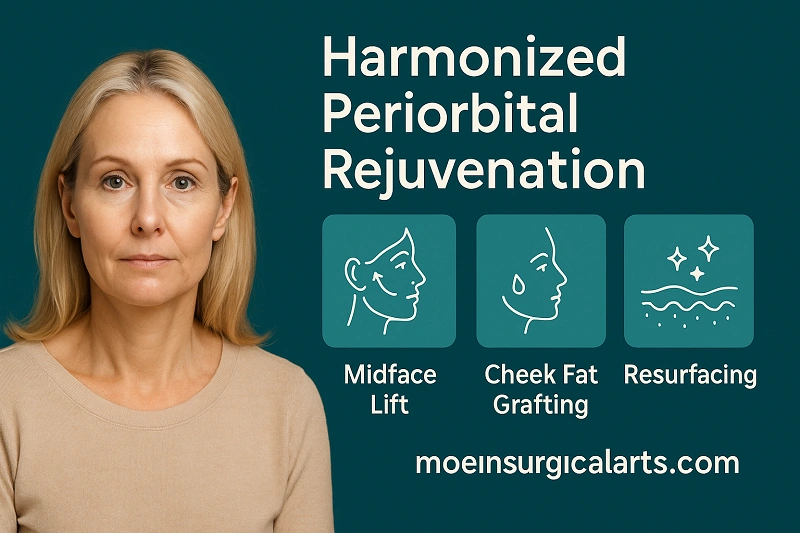
Often the most natural results come from combining lower eyelid surgery with adjacent procedures: midface lift, cheek augmentation (fat grafting), or resurfacing (laser, chemical peel). These procedures address the support/volume balance that causes the bag/hollow contrast and produce a longer-lasting, harmonious outcome.
Lower Blepharoplasty Recovery Timeline & Risk Mitigation — What To Expect
| Phase / Topic | What To Expect | Risks & How To Minimize |
|---|---|---|
| First Week | Swelling & bruising peak at days 2–3 and begin to subside. Use cold compresses, keep head elevated, and take short-term medications as directed. Expect limited social contact for ~7–14 days. Tip: Head elevation & cold packs | Risks: Bleeding, infection, temporary eyelid position changes (ectropion/retraction). Minimize by: Strict postop instructions, avoid straining, follow meds, and call immediately for heavy bleeding or fever. |
| Weeks 2–4 | Most normal activities resume; mild swelling may linger. Typical return-to-work: 10–14 days. Begin light activity per surgeon guidance. Tip: Gentle activity, avoid heavy lifting | Risks: Asymmetry, persistent swelling, or early eyelid malposition (rare). Minimize by: Early follow-up visits, conservative measures (massage, ointments), and prompt reporting of concerns. |
| Months 1–3 | Final contour emerges as residual swelling resolves. Scars fade; incision lines under the lashes typically become well-hidden. Tip: Sun protection & scar care | Risks: Contour irregularities, dry eye symptoms. Minimize by: Lubricating eye drops if needed, follow scar-care plan, and schedule evaluation for persistent issues. |
| Long Term | Fat removal/repositioning and skin refinement create a stable improvement. Natural aging continues, but baseline appears refreshed for many years. Tip: Maintain skincare & healthy lifestyle | Risks: Late eyelid laxity or recurrence with aging. Minimize by: Long-term follow-up; consider adjunctive midface or skin-tightening procedures if needed; avoid smoking and excess sun. |
How to Choose the Right Eyelid (Blepharoplasty) Surgeon in Los Angeles?
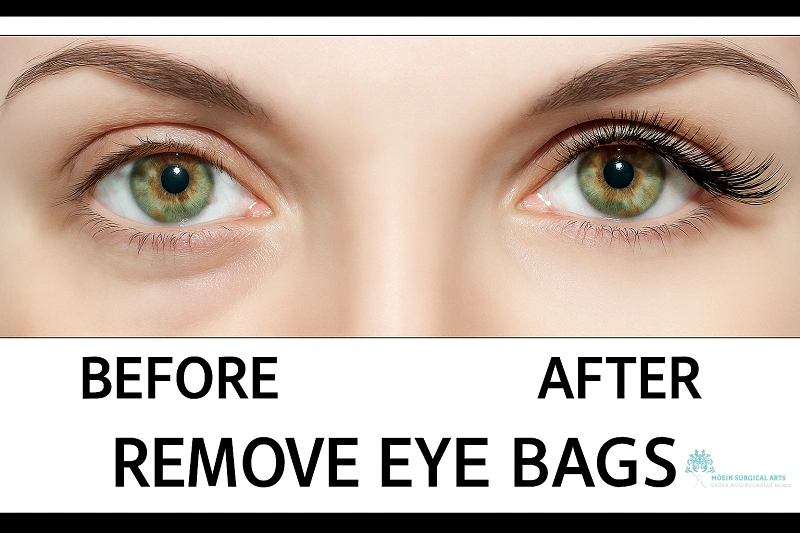
Choosing a surgeon for eyelid surgery is one of the most critical decisions one will make. There are many skilled surgeons in Los Angeles; selecting one involves looking at credentials, experience, and the practice’s attention to patient safety and long-term outcomes. Below is a convenient checklist, along with local recommendations, designed to help patients make informed decisions
Why Los Angeles matters (and where patients travel from)?
There are additional aesthetic specialists located throughout Greater Los Angeles, from Beverly Hills and West Los Angeles to Santa Monica, Pasadena, and Glendale. Some patients come from surrounding cities, such as Orange County, Long Beach, Ventura, and the Inland Empire, to enjoy the services of talented surgeons and accredited facilities. Select a surgeon in this region based on their experience with eyelid dissection and outcomes, rather than proximity.
Key features to look for in an eyelid surgeon
Credentials & Proven Experience
Look for a surgeon with focused eyelid experience (regular lower blepharoplasty and periorbital work), formal board training in plastic/facial or general surgery, and a steady case volume. Ask for before/after photos of patients with similar anatomy, consistent, natural results matter most.
Safety, Facility & Anesthesia
Confirm the operation will occur in an accredited facility (ASC or hospital) with board-certified anesthesia providers and standard perioperative safety protocols. Facility accreditation and hospital privileges are essential safety signals.
Consultation Quality & Surgical Technique
Choose a surgeon who offers a comprehensive consultation: detailed exam, discussion of alternatives (fat removal vs repositioning, midface support), clear risks, and realistic expectations. Prefer anatomy-preserving techniques (conservative fat handling, repositioning when appropriate) to avoid an over-resected, hollow look.
Aftercare, Outcomes & Reputation
Ensure the practice provides structured postoperative follow-up, early visits, clear instructions for swelling/bruising, and long-term monitoring for complex cases. Check independent patient reviews, ask for referrals, and prioritize surgeons recommended by trusted clinicians.
Recommendations for Los Angeles patients
- Compare at least two consultations before making a decision.
- Please request photographs of recent cases from the surgeon’s gallery that correspond to your age and anatomical structure.
- Verify facility accreditation and inquiry regarding emergency measures.
- Patients with dry-eye disease or a history of previous eye disease should seek a surgeon who closely collaborates with an ophthalmologist.
Why Consider Dr. Babak Moein in Los Angeles?
Dr. Babak Moein offers one-to-one eyelid and facial attention in a multispecialty practice located in Los Angeles. With extensive surgical experience and expertise in both aesthetic and reconstructive surgery, Dr. Moein prefers conservative surgical approaches that spare anatomy, foster open communication, and ensure systematic postoperative care. His practice offers consultation visits that closely consider opportunities for surgery, such as transconjunctival versus transcutaneous incisions, fat relocation, and other support for the midface, as well as extensive postoperative planning and access to accredited surgical facilities in Southern California.
To schedule a consultation with Dr. Babak Moein at Moein Surgical Arts — Los Angeles: Call: (310) 455-8020 Book online: https://moeinsurgicalarts.com/contact/Considering a breast augmentation but afraid to go with implants? You are one of many. Increasing numbers of women are learning about fat transfer breast augmentation and are looking at this “all natural” alternative, and one of the Beverly Hills fastest growing cosmetic procedures.
Dr. Babak Moein at Moein Surgical Arts is skilled in high-end fat transfer procedures that use VASER liposuction, the latest VASER, and high-definition fat grafting for unrivaled, naturally pleasing results. Everything you should know about fat transfer augmentation in 2025 is covered in this in-depth guide.

What is Fat Transfer Breast Augmentation?
Fat transfer breast augmentation uses fat from your body to enlarge your breasts. Surgeons suction fat cells from several areas of your body and then inject the fat cells into your breasts. Your breasts get bigger while the areas of your body that lost fat cells get smaller.
This innovative procedure, also known as natural breast augmentation or autologous fat grafting, offers a “two-for-one” benefit: body contouring through liposuction combined with breast enhancement using your own tissue.
How Fat Transfer Breast Augmentation Works?
The procedure involves three precise steps:
1. Fat Harvesting with VASER Liposuction The surgeon uses liposuction to remove fat from the donor site – typically the abdomen or flank areas, but fat can be harvested from anywhere. At Moein Surgical Arts, Dr. Moein uses advanced VASER technology for gentler fat extraction, which improves fat cell survival rates.
2. Fat Processing and Purification The fat is harvested into a closed, sterile container. There are different systems for how you harvest that fat – the fluid is then drained off, which you have to do when it comes to the breast. This critical step ensures only the healthiest fat cells are used for transfer.
3. Precise Fat Injection The surgeon takes that supernatant (pure) fat and injects it with a very small (less than 3mm) cannula using multiple passes into the breast itself. This technique allows for precise control over volume and shape, creating natural-looking results.
Ideal Candidates for Fat Transfer Breast Augmentation
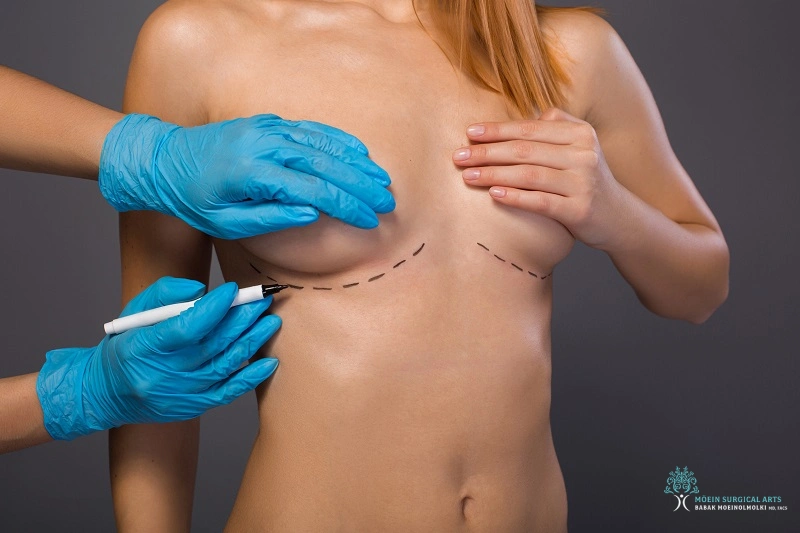
Not everyone is an eligible candidate for the procedure. The thin people who lack a significant amount of body fat are perhaps not eligible for fat transfers. Your provider has to be able to harvest greater than they are transplanting fat cells since some die during the procedure
Ideal Candidates are:
Healthy women who desire small to medium size augmentation (1-2 cup sizes)
Sufficient donor fat in areas like abdomen, thighs, or flanks
Stable weight for at least 6 months
Non-smokers (heavy smoking strongly affects healing and fat viability)
Reasonable expectations for results and length
Good skin elasticity in the breast area
Who Should Consider Implants Instead:
- Women wanting dramatic size increases (more than 2 cup sizes)
- Those with insufficient body fat for harvesting
- Patients seeking immediate, predictable volume
- Women with significant breast sagging requiring a lift
Fat Transfer Breast Augmentation: What to Expect at Moein Surgical Arts
Pre-Operative Consultation
During your consultation with Dr. Moein, you’ll receive:
- Comprehensive physical examination
- Discussion of aesthetic goals and expectations
- Assessment of donor sites and breast tissue
- Detailed explanation of the procedure and recovery
- Review of before-and-after photos from similar cases
Surgery Day Experience
A fat transfer breast augmentation is an outpatient procedure. You go home the same day. You receive general anesthesia to help you sleep through the surgery.
Duration: 3-5 hours (depending on the extent of liposuction and fat transfer) Anesthesia: General anesthesia administered by board-certified anesthesiologists Setting: AAAHC-accredited surgical facility
Dr. Moein’s Advanced Technique
Dr. Moein employs specialized protocols including:
- VASER liposuction for optimal fat cell preservation
- Closed-system processing to maintain fat cell integrity
- Multi-layer injection technique for even distribution
- Renuvion skin tightening when appropriate for donor sites
Benefits of Fat Transfer Breast Augmentation

Fat Transfer vs. Breast Implants: Making the Right Choice
Cost Comparison (2025 Pricing)
Fat Transfer Breast Augmentation:
- Average cost of breast augmentation with fat grafting is $5,719
- Range: $3,000 to $11,000
- More expensive initially but no future replacement costs
Breast Implants:
- Average cost of breast augmentation with implants is $4,875
- Traditional breast implants typically range from $6,000 to $12,000
- May require replacement every 10-15 years
Long-term Value Analysis
Fat grafting to the breast is more expensive than a breast augmentation using implants. That may seem counter intuitive since you’re using your own fat, but you are really getting two procedures: breast augmentation and Lipo 360!
While fat transfer typically involves a higher initial investment, implants often require replacement surgery every 10-15 years. Think of it as choosing between a higher upfront cost versus potential long-term maintenance expenses.
The Hybrid Approach: Combining Fat Transfer with Breast Implants
Sometimes the answer to fat transfer breast augmentation vs implants isn’t either/or, it’s a combination! The combination method is increasingly popular for the patient desiring the predictable volume of the implant and the softer natural contouring achievable only through fat.
Advantages of the Combination Approach:
- Enhanced naturalness: Fat camouflages implant edges
- Increased fullness in the upper pole: Improved breast shape
- Correction of rippling: Smooths any surface implant
- Customized results: Combines predictable volume with natural contouring
Advanced Technologies at Moein Surgical Arts
VASER Liposuction for Fat Harvesting
Dr. Moein utilizes state-of-the-art VASER (Vibration Amplification of Sound Energy at Resonance) technology for:
- Gentler fat extraction with higher cell viability
- Improved body contouring results
- Faster recovery times
- Better skin tightening in donor areas
Renuvion Skin Tightening
When appropriate, Dr. Moein combines fat transfer with Renuvion J-plasma technology to:
- Tighten loose skin in donor areas
- Enhance body contouring results
- Minimize the need for skin removal procedures
2025 Trends in Fat Transfer Breast Augmentation
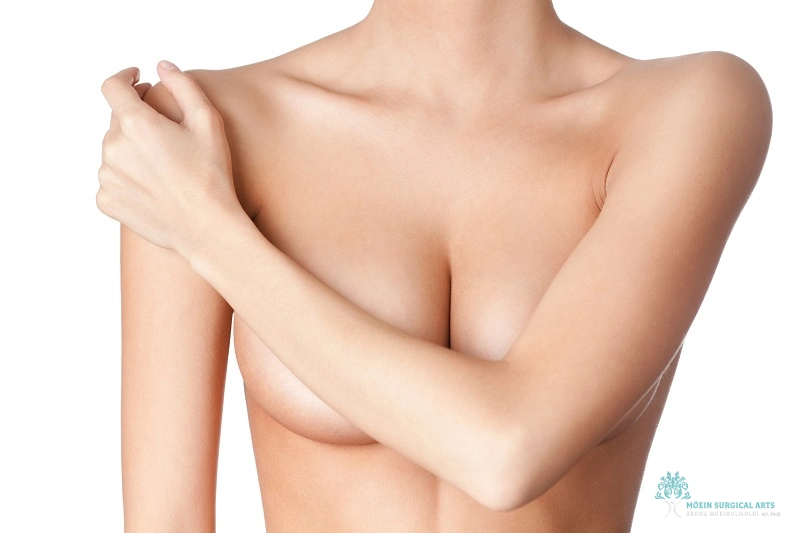
Increased Popularity
Fat Transfer: Increasingly, surgeons are opting for fat grafting in combination with implants for optimized, natural softness and harmony. The move reflects the growing patient preference for natural-looking outcomes.
Technical Improvements
- New fat processing technologies increasing the survival rates
- New injection technologies for more reliable outcomes
- Combination procedures for the best results
- Enhanced safety protocols
Patient Demographics
More patients are choosing fat transfer as awareness increases about:
- Natural alternatives to implants
- Dual benefits of body contouring
- Long-term safety considerations
- Improved surgical techniques
Why Choose Dr. Moein for Fat Transfer Breast Augmentation in Los Angeles?
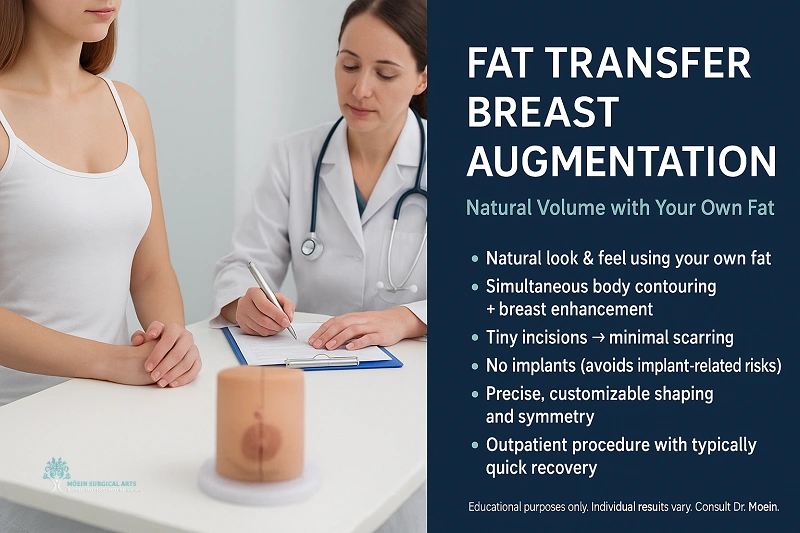
Dr. Moein’s Expertise and Credentials
Dr. Babak Moein brings over 15 years of specialized experience in cosmetic surgery to every procedure. As a board-certified cosmetic surgeon with FACS designation, he represents the highest standards in surgical excellence. Dr. Moein has completed advanced fellowship training in aesthetic surgery techniques and serves as teaching faculty, where he shares his expertise with the next generation of surgeons.
Actual Results of Fat Transfer and Patient Experiences
Dr. Moein’s fat transfer breast augmentation clients consistently share their tales of achievement in 5-star testimonials and detailed reviews. They comment in support of the natural-looking results and the dual benefits of body contouring and the skill in achieving their aesthetic goals. Read authentic fat transfer experiences and view before-and-after galleries on our patient reviews page and testimonials section.
Customized Protocols for Fat Transfer Treatment
Every fat transfer breast augmentation performed by Moein Surgical Arts is carefully individualized to meet your specific needs and achieve the desired outcomes. Dr. Moein personally evaluates the donor sites you are a candidate for, the breast anatomy and aesthetic goal in one-on-one consults and provides 24-hour post-op support during the natural breast enhancement recovery.
Schedule Your Consultation
Ready to discover if fat transfer breast augmentation is right for you? Contact us at (310)-455-8020 to schedule your consultation with Dr. Moein.
Special offers include:
- Comprehensive consultations
- 0% financing options
- All-inclusive care packages
- Early signup bonuses
Ready to Start Your Natural Transformation?
Schedule your consultation with Dr. Moein today and discover the natural, beautiful results of fat transfer breast augmentation
 Limited Time Offers
Limited Time Offers
Join hundreds of satisfied patients who have trusted Dr. Moein for their aesthetic transformation
]]>
It is crucial for all potential neck lift and lower facelift patients to understand what to anticipate during the postoperative recovery process. This process comprises several phases with clear distinctions, with the first fourteen days often representing the most dynamic changes in the swelling and bruising configurations. Total recovery and ultimate aesthetic results reveal themselves over the course of a number of months, yet the individual patient’s recovery will vary due to numerous factors.
At Moein Surgical Arts, it is our goal to provide the following comprehensive recovery chronology so that you will feel better mentally and physically equipped to deal with each stage of transformation with appropriate anticipation and awareness necessary for best healing results.
Table of Contents
- Neck Lift and Lower Facelift Recovery Pictures Day by Day
- Understanding Neck Lift and Lower Facelift Procedures
- Pre-Surgery Preparation for Optimal Face Lift Recovery
- Factors Affecting Neck Lift Recovery Timeline
- Neck Lift Lower Facelift Recovery Pictures Day by Day: Your Transformation Results with Dr. Moein
Table of Contents
Understanding Neck Lift and Lower Facelift Procedures
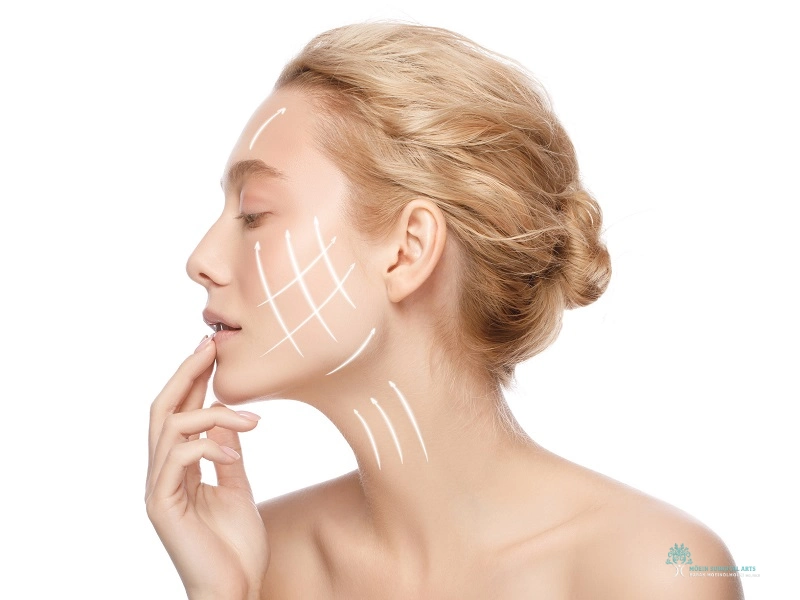
A neck lift (platysmaplasty) deals with laxness of the skin, fat deposits, and banding of the neck muscles, whereas the lower facelift deals with the lower face, jowls, and jaw line. In the majority of cases, these surgeries are also conducted at the same time for symmetry in aesthetic appearance between the jaw line down to the décolletage.
Incisions during surgery are most often located behind the ears and occasionally the chin. Excessive skin is excised by the surgeon, who tightens weakened muscles below the skin’s surface. Tissues are then reset for an improved, younger-looking contour. Complexity with your individualized procedure will determine the length of recovery.
Pre-Surgery Preparation for Optimal Face Lift Recovery
Your recovery journey actually begins before surgery. Following pre-operative instructions carefully can significantly impact your healing process. This includes avoiding certain medications, stopping smoking, arranging for post-operative care, and preparing your recovery space with necessary supplies.
Day 1: Immediate Post-Operative Period
The initial day following the neck lift and lower face-lift is very important for initiating the course of the recovery. You will awake with surgical dressings and potentially with drainage tubes. These drains are utilized to keep fluid away and minimize the swelling.
What to Expect:
- Moderate to significant swelling and bruising around the surgical sites
- Tightness and numbness in the treated areas
- Mild to moderate discomfort, manageable with prescribed pain medication
- Drowsiness from anesthesia
- Restricted neck movement
Visual Appearance
The surgical areas will at this point have dressings applied so it will not be easy to judge the ultimate results. There will likely be swelling and discoloration in the areas that are exposed. This is normal. You will most likely feel tight on the face and neck.
Care Instructions:
Hold your head high when lying down
Follow prescribed medicine as directed
Apply cold compresses as recommended
Avoid bending over or straining Follow all post-operative care instructions
Days 2-3: Early Recovery Stage

In the second and third days, the worst swelling and black-and-blue discoloration will most likely happen. This is the most troublesome recovery period for most clients, but keep in mind that this is temporary and part of the natural healing process.
What to Expect:
- Severe swelling and bruisingsw
- Continued tightness and some numbness
- Potential mild nausea due to pain medicine
- Difficulty with certain facial expressions
- Sleep disruption caused by requirements for positioning
Visual Changes:
The swelling may make your face appear quite different from your normal appearance. Bruising typically appears as purple or dark blue discoloration around the ears, neck, and jawline. Some patients also experience bruising that extends down to the chest area.
Important Milestones:
First post-operative appointment (generally on day 2 or 3) Possible drain removal Initial wound assessment, Titration of medicines when necessary
Days 4-7: First Week Progression
By the fourth postoperative day, you will already feel better. Even though the brusing and swelling are not yet gone, some people feel partly better with additional mobility.
What to Expect:
Gradual reduction in pain levels
Minimal reduction in swelling (but still high)
Improved sleep quality
Insatia or
Increased tolerance for short activities
Visual Development:
The bruising may begin to change colors, transitioning from deep purple to lighter shades of blue, green, and yellow. This color progression is a positive sign of healing. The swelling may start to become more localized rather than generalized.
Activity Level:
You may generally return to gentle activity such as taking short walks through the house. Try to steer clear of strenuous activities, heavy lifting, or neck-straining motion.
Days 8-14: Recovery during the Second
The second week often brings more noticeable improvements. Many patients feel ready to return to work (depending on their job requirements) and social activities, though full healing is still months away.
What to Expect:
Markedly diminished pain
Reversible decrease in swelling
Improved range of motion in the neck
Return of some facial sensation
Improved energy levels
Visual Progress:
By the second week, most of the dramatic swelling will have diminished, so you will begin to see glimpses of the new look. Bruising will continue to dissipate and will often be obscurred by makeup. Lines where the cuts have been will still be apparent but will be healing nicely.
Activity Milestones:
Returning to desk work (with doctor approval) Light exercise like walking encouraged Social activities with close friends and family Driving permitted (if not taking pain medications)
Days 15-21: Third Week Enhancements

The third week is usually the turning point in the recovery. Patients feel much better and are less apprehensive in how they look.
What to Expect:
Minimal pain or discomfort
More relief for swelling
Skin texture and feel enhanced
Better sleep on numerous sides
Increased confidence in appearance
Visual Changes:
The new neck and jawline contour becomes more apparent as swelling subsides. Any remaining bruising is typically minimal and easily covered with makeup. The skin may still feel slightly tight, but this sensation gradually improves.
Expanded Activities:
Return to regular working operations Light exercise routines Social activities
The Regular grooming and skin-care procedures (according to surgeon’s instructions)
Weeks 4-6: One Month Mark
Reaching the one-month milestone is significant in your recovery journey. By this time, you should see substantial results from your neck lift and lower facelift.
What to Expect:
Minimal residual swelling
Re-established facial sensibility
Comfortable sleeping in any position
Full range of neck motion
High satisfaction with initial results
Visual Evaluation:
The main swelling will subside, so you will also have a pretty good idea how your final results will appear. You will note an improved-appearing neck with a better contoured, younger appearance. Incision lines will still refine with time and diminish.
Activity Resumption:
Most normal activities
Regular exercise (with permission) Full-time working schedule Regular social activities Photography for documentation
Months 2-3: Continued Refinement
The second and third months of recovery see delicate but crucial alterations as the tissues settle down further with their new placement.
What to Expect:
Ongoing enhancement in skin texture
Further reduction in the remaining swelling
Complete restoration of facial sensation
Adaptation to novel face shapes
Greater satisfaction with outcomes
Long-term Recovery: Over this period, the deeper tissues also start to repair and fortify. The skin also becomes settled in its new position, with the final shape becoming sharper. All the numbness or other sensations also typically fade over this period.
Months 4-6: Near-Final Results
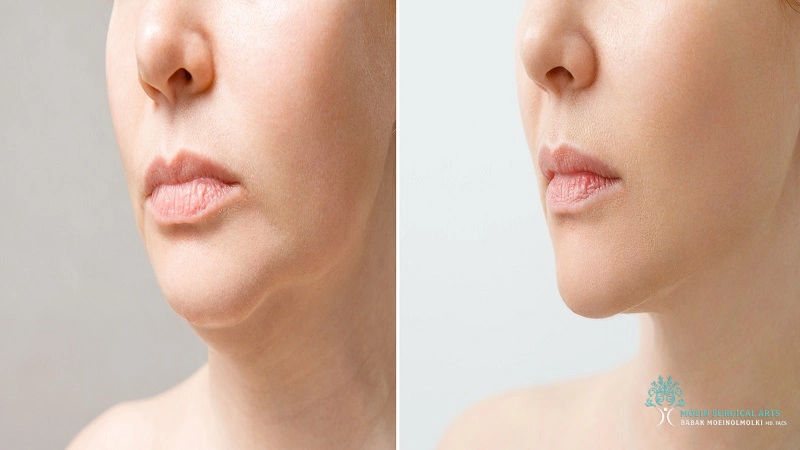
By four to six months post-surgery, you should see results that closely represent your final outcome. The healing process is largely complete, though some subtle changes may continue for up to a year.
Visual Maturation:
The jawline and neck will reveal their final shape with nicely healed scars that are not appreciable. Skin texture will also be excellent with a natural, young-appearing look that will seem compatible with your face.
Long-term Satisfaction:
Most patients are highly pleased with the result at this stage. The improved neck and jawline definition should cause the face to appear slimmer, sharper with an overall increase in facial attractiveness.
Factors Affecting Neck Lift Recovery Timeline
Several factors influence how quickly you recover after surgery:
Age & Skin Quality: Younger patients with better skin elasticity typically heal faster.
Overall Health: Adequate nutrition, exercise, and overall health help for quick recovery.
Smoking Status: Non-smokers also tend to recover quickly and have less complication.
Procedure Complexity: More extensive surgeries require longer recovery times.
Post-Operative Care: Strictly following your surgeon’s instructions speeds healing.
Genetics: Individual healing abilities vary based on genetic factors.
Tips for Optimal Recovery
For the best possible healing and results:
- Follow Instructions: Be sure to follow all post-op instructions.
- Maintain Nutrition & Hydration: Promote tissue repair with a balanced diet and appropriate fluid intake.
- Skin Protection: Use sunscreen and tender skin preparations as recommended.
- Be Patient: Recovery is not an overnight thing. Give your body the time.
- Stay Connected: Follow up with your surgical team and attend follow-ups for monitoring progress.
Neck Lift Lower Facelift Recovery Pictures Day by Day: Your Transformation Results with Dr. Moein
Recovery from neck lift and lower facelift surgery requires patience and proper care, but the long-term results provide years of enhanced confidence and natural-looking rejuvenation.

About Dr. Moein and Moein Surgical Arts
Dr. Moein is a board-certified cosmetic surgeon with years of specialized experience in facial cosmetic surgery, including advanced neck lift and lower facelift techniques. Located in Los Angeles, our state-of-the-art surgical facility combines cutting-edge technology with personalized patient care to deliver exceptional results.
Ready to Begin Your Transformation?
If you’re considering a neck lift or lower facelift, we invite you to schedule a consultation with Dr. Moein. Our team will assess your individual needs and create a customized treatment plan designed to achieve your aesthetic goals.
Contact Information:
- Phone: (310)-455-8020
- Location: Los Angeles, CA
- Consultation: Complete our online contact form to schedule your personalized consultation
Your journey to a more youthful, confident appearance starts with understanding the process. Trust your transformation to the experienced hands of Dr. Moein and the dedicated team at Moein Surgical Arts.
]]>Lipedema is a chronic disease that causes irregular fat deposition, pain, swelling, and easy bruising, generally of the legs and arms, and is not amenable to diet and exercise. Cellulite is a cosmetic condition in which typical fat bulges against connective tissue, producing skin dimpling without pain, swelling, or other manifestations of disease. The most significant differences are affected sites, type of fat, and symptoms: lipedema involves pathological fat with medical symptoms (arms and legs, not hands and feet), whereas cellulite involves normal fat and mostly affects buttocks, thighs, and abdomen.
Lipedema and cellulite, while too often and improperly employed synonymously, are not twin disease conditions but two forces imprinted on the skin and on the body. Both produce a topography of irregular surface and dimpling, and the etiologies from which they arise are clearly different. Lipedema is a progressive, pathologic illness and cellulite falls into the realm of the aesthetic nuisance, a condition ubiquitously present on and across the human body.
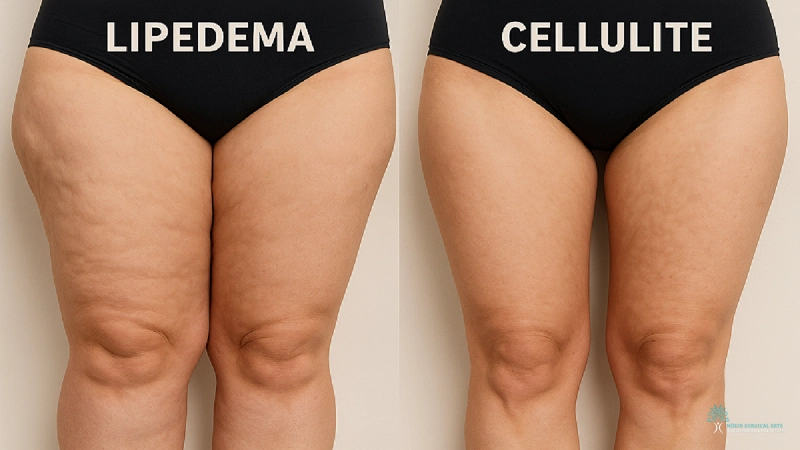
Far too commonly, unwanted bulk in the thighs, water retention in the hips, or unevenness in the arms is brushed aside as pesky fat or run-of-the-mill cellulite. All too often, that diagnosis masks the presence of lipedema disease, which can only be diagnosed and treated by a doctor. Such a misdiagnosis instigates a delay in treatment, more physical misery and awakening a dormant misery in the Self.
The distinction is the key. Understanding where lipedema diverges from cellulite is not semantics but body ownership of health. Accurate identification is the key to proper diagnosis, prompt treatment, and restored faith in the body silhouette. It empowers patients not only to the pursuit of cosmetic idealization but to treatment of a condition that, untreated, will become sweeping health handicaps.
Here, lipedema and cellulite will be uncovered in simplicity, what they are, in ways how their appearances differ, the secret danger of lipedema, and the new treatments that promise. Discernment is freedom: freedom in being able to discern the difference between the aesthetic and the chronic, and the recovery of control over health and over self.
What is Lipedema?
Definition of Lipedema
The condition of lipedema is a chronic fat tissue disease, predominantly in women. It develops or worsens in the case of severe hormone changes such as puberty, pregnancy, or menopause. What is most infuriating about it is the failure of the fat in lipedema to respond to diet and exercise programs. It occurs in the hips, thighs, buttocks, and in the lower legs, although the arms can be a part of a minority of cases. In the disease, it is apparent that the bottom half is out of proportion in comparison to the upper half, and a distinct border of delineation is observed across the wrists or the ankles. It generates a column shape of arms and legs.
Causes and Risk Factors of Lipedema
The cause is unknown, but genetics and hormones have been found to be the strongest determinants, based on research. Sixty percent of individuals who have lipedema have family members who are afflicted. Estrogen is believed to be a cause, and that is the reason why women are nearly always afflicted.
↳ Family history of lipedema
↳ Puberty, pregnancy, menopause, or other hormonal changes
↳ Female sexuality, apart from in a few rare instances in men
Symptoms of Lipedema
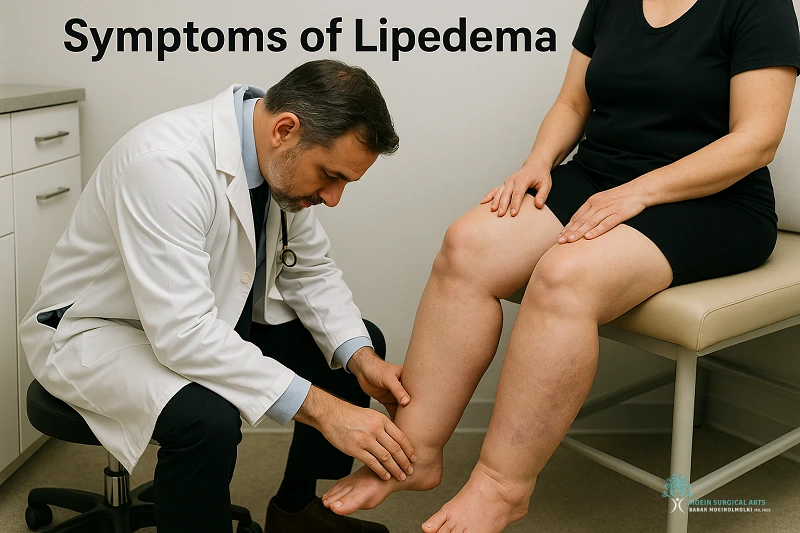
The condition is more than aesthetics. It is a condition that is accompanied by pains in its symptoms. Its most common symptoms are symmetrical fat deposition in the arms and in the legs, heaviness, or pains in the limbs, and bruises in the skin. It is colder in feeling than the rest of the part it covers. It is more apparent in the form of swelling over time, and the feet are exempt, and it is what eventually makes it distinct from the rest of diseases.
How Lipedema Progresses Over Time
The condition is progressive, which means it will be getting progressively worse unless it is treated. In the earlier stages, it may appear the same as cellulite or normal fat deposits, but the further it goes, the more it will inhibit activity and make day-to-day living more difficult. At higher levels, lipedema becomes lipo-lymphedema. It is a condition that develops if the lymph system is damaged, which leads to swelling and further issues.
In Los Angeles’ Moein Surgical Arts, Dr. Babak Moein attends patients regularly who had lipedema for years, without ever being aware of the condition. Proper identification of symptoms and awareness of the real condition is a giant stride in the way of treatment, alleviation of symptoms, and recovery toward comfort and mobility.
What is Cellulite?
Definition of Cellulite
Cellulite, often described as “orange-peel” or “cottage cheese” skin, is a cosmetic condition that occurs when fat deposits push against fibrous connective tissue beneath the skin. This creates the dimpled or uneven surface many people notice. Unlike lipedema, cellulite is not considered a medical disease but rather a common variation in how fat is stored in the body.
Causes and Risk Factors of Cellulite
Cellulite can appear in individuals of any body type or weight. It is more common in women due to natural differences in fat distribution, connective tissue, and hormonal influences. Several factors may increase the likelihood of developing cellulite:
↳ Genetics that influence skin and fat structure
↳ Hormonal fluctuations, particularly involving estrogen
↳ Aging, which reduces skin thickness and elasticity
↳ Sedentary lifestyle and reduced muscle tone
↳ Poor nutrition or chronic dehydration
Symptoms and Appearance of Cellulite
Cellulite is not harmful and does not cause physical pain or medical complications. Its hallmark sign is an uneven, lumpy skin texture, most frequently noticed on the thighs, hips, buttocks, and abdomen. It may become more visible when the skin is pinched or when light casts shadows across the affected area.
How Common is Cellulite?
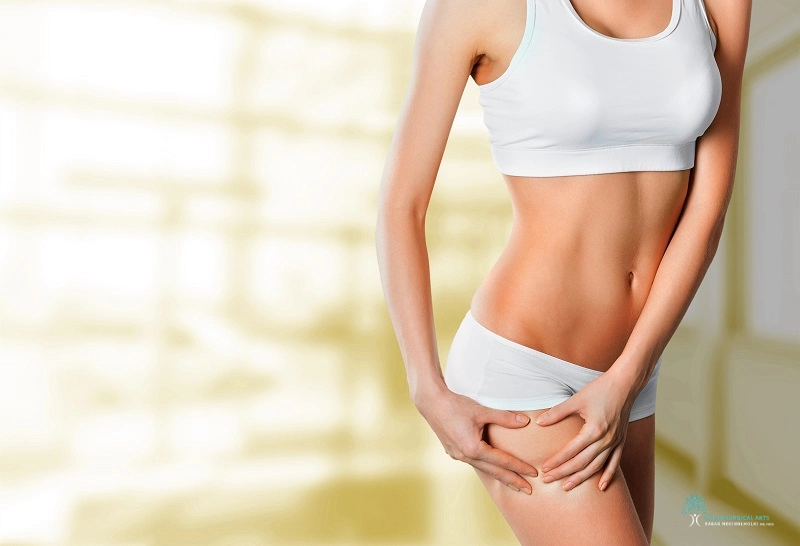
Cellulite is extremely widespread. Studies estimate that 80 to 90 percent of women will develop it at some point in their lives. Even individuals with low body fat or high physical fitness levels, including athletes, can have cellulite. This makes clear that cellulite is not simply tied to weight but is instead a normal variation in skin and fat anatomy.
Lipedema vs. Cellulite: The Main Differences
Differences in Causes
Lipedema is a chronic medical condition associated with abnormal fat tissue, influenced by hormones and genetics. Cellulite is a cosmetic condition brought about by fat pressing against connective tissue under the skin.
Differences in Appearance
Lipedema causes symmetrical swelling, resulting in column-like arms or legs that may be painful and tender. Cellulite appears as dimples or an “orange peel” texture, altering the texture of the skin without pain in deeper tissues.
Differences in Symptoms
Cellulite is symptomless physically aside from appearance. Lipedema tends to be painful, heavy, sensitive, and prone to bruising, which can really impact everyday comfort.
Differences in Progression
Cellulite tends to be stable over time. Lipedema is progressive and, if untreated, may become worse, occasionally restricting mobility and resulting in complications like lipo-lymphedema.
You can see this comparison in the table below:
| Feature | Lipedema | Cellulite |
|---|---|---|
| Type | Chronic Medical Condition | Cosmetic Condition |
| Causes | Hormonal & Genetic Factors | Fat Pressing Against Connective Tissue |
| Appearance | Symmetrical Swelling, Column-like Limbs | Dimpled, “Orange Peel” Texture |
| Pain Level | Painful & Tender | No Pain |
| Symptoms | Heavy Feeling, Bruising, Sensitivity | Appearance Changes Only |
| Progression | Progressive (Worsens Over Time) | Stable (Remains Consistent) |
| Affected Areas | Arms, Legs (Symmetrical) | Thighs, Buttocks, Abdomen |
| Treatment Need | Medical Treatment Required | Optional Cosmetic Treatment |
How to Tell the Difference؟
Key Signs to Watch
↳ Pain, tenderness, and easy bruising are indicative of lipedema, not cellulite
↳ Swelling that spares hands and feet is typical of lipedema
↳ Cellulite is superficial and cosmetic, not associated with discomfort or heaviness
Diagnosis
Since cellulite is not harmful, there is no need for any medical assessment. Lipedema needs to be diagnosed by a professional. A doctor will take a history, inspect the affected area, and sometimes request imaging tests to diagnose the condition.
When to Visit a Doctor؟
If your legs are always heavy, hurt, or bruise for no obvious reason, it’s time to see an expert. Those are not symptoms of normal cellulite. At Moein Surgical Arts in Los Angeles, Dr. Babak Moein evaluates and treats patients who are probably living with undiagnosed lipedema, bringing relief and restoring mobility.
Health Risks Associated with Lipedema
Physical Complications
problems. Pathological accumulation of fat prevents circulation, lymphatic circulation, and joints. Lipedema that is progressive renders the limbs clumsy, so performing simple activity such as a walk or climbing the stairs is an issue. Tender skin and annoying aches are common grievances.
If not treated, lipedema can progress to lipo-lymphedema, in which the lymph vessels are unable to drain fluid properly. It causes swelling and susceptibility to infections. Excess weight also causes undue stress on hips, knees, and ankles, usually accelerating arthritis.
Emotional and Psychological Effects
The emotional impact may be extreme as well. Most women experience loneliness, embarrassment, and frustration. Since lipedema can also be mistaken for being obese, patients are inappropriately instructed to “lose weight,” which results in meaningless dieting and broken self-esteem. This escalates to avoidances and depression and anxiety.
Why It Should Not Be Ignored?
Lipedema is progressive. Pain, swelling, and mobility impairments exacerbate if left untreated. Early detection and treatment are essential in order to slow its development and maintain quality of life.
Health Risks Associated with Cellulite
Is Cellulite Harmful?
Cellulite is not a disease and is not a health risk. It will not prevent mobility, circulation, or the function of the organs. It does have a cosmetic effect; therefore, the treatment is elective.
Psychological and Self-Esteem Impact
Even benign conditions have emotional connotations. It is socially accepted to associate smooth skin with beauty, and hence, most women are insecure about cellulite. Insecurity drives spending on treatments and creams even further, being supplemented by media portrayal of the “perfect” body. Cellulite does not require medical intervention, but maintaining self-esteem and a healthy self-concept is still vital.
Treatment for Lipedema
Lifestyle Interventions (Diet & Exercise)
Lifestyle modifications can’t cure lipedema but can alleviate symptoms and slow disease progression. An appropriate diet, which includes anti-inflammatory diet, can alleviate discomforts and inflammation. Gentle exercise such as swimming, cycling, or a leisurely walk can enhance circulation, strengthen muscle, and introduce mobility. It is essential, however, to recognize that dieting in the manner ordinary people diet won’t accomplish fat loss in the context of lipedema, so a helpful but not corrective intervention is a helpful lifestyle modification.
Compression Treatment
Compression therapy is a very effective non-surgical therapy for lipedema. Compression clothing specifically created for the purpose can alleviate inflammation, aid lymphatics, and alleviate arm and leg soreness. It doesn’t eliminate fat, but compression makes life more livable and offers a quality of life gain.
Liposuction for Lipedema
Many patients require liposuction, tumescent liposuction, water-assisted liposuction, or their combination, in combination with compression therapy, for successful lipedema fat removal. Unlikve cosmetic liposuction, the surgery is medically controlled, removing fat cells diet and exercise can’t eliminate so. In addition to enhancing body proportion, liposuction diminishes pains, heaviness, and risk of disease advancement.
Long-Term Treatment
Lipedema is a chronic disease, and even following a successful liposuction, it must be controlled. Individuals still must reside a healthy life, wear compressive apparel, and continue manual lymphatic drainage therapy where applicable. Lifelong management is the remedy for feeling comfortable living with lipedema.
Treatment Options for Cellulite
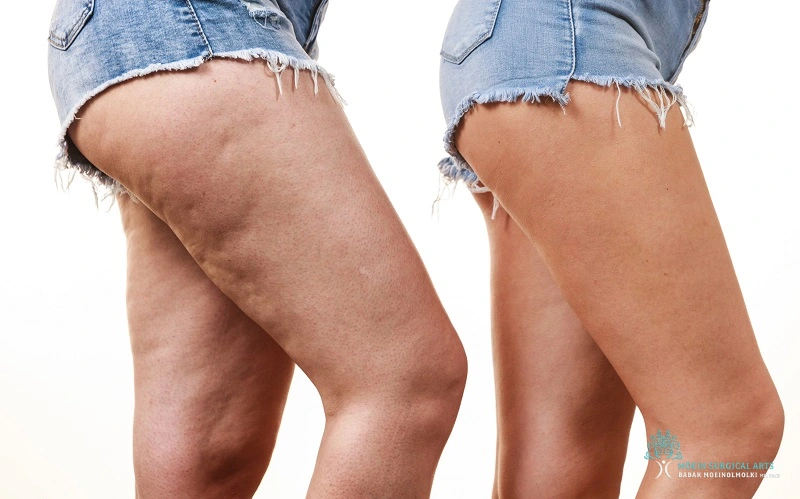
Topical Creams and Lotions
There are numerous over-the-counter creams promising the elimination of cellulite, almost all of them containing caffeine, retinol, or a combination. Some, in the short term, may tighten the skin in the area of application and/or enhance skin circulation, but the effects are generally slight and temporary.
Non-Surgical Cosmetic Treatment
There are a number of non-surgical cellulite treatments, including: Laser treatment: Kills fat cells and firms collagen. Radiofrequency procedures: Evens out the uneven look and firms the skin. Acoustic wave therapy: Kills bands of connective tissue with sound waves. These may work, but are unpredictable and usually have to be repeated dozens of times.
Surgery treatment
Advanced cases of cellulite can be operated on, for example, subcision (cutting the fibrous bands of connective tissue under the skin) or laser liposuction. These may be longer-lasting, but also more risky and invasive.
Lifestyle Management
Proper exercise, proper drinking and eating, and a balanced diet will reduce the appearance of cellulite. Building up muscle tone and overall reducing body fat should also improve the look of the skin, although the cellulite will usually be present in some way because it’s more body-structure-rather-than-weight-based.
Lipedema vs. Cellulite: Consultation, and Next Steps in Los Angeles
Lipedema and cellulite may sound like interchangeable terms, but lipedema is an ongoing condition that impacts circulation, mobility, and comfort of daily life. Lipedema must be appropriately diagnosed and treated early before it advances.
Dr. Babak Moein of Moein Surgical Arts in Los Angeles offers advanced lipedema surgery, such as advanced liposuction procedures, to remove unhealthy fat and alleviate symptoms. Lipedema surgery is also now commonly covered by most insurance companies as a medically necessary procedure. Our experts work individually with patients and assist in preparing medical forms and walking patients through the pre-authorizations process.
To find out more, check coverage, or make an appointment, call us at (310) 455-8020 or complete our secure online contact request today. Beginning your care can restore mobility, relieve pain, and revive self-esteem.
]]>For many men, stubborn abdominal skin and fat pockets can linger despite a disciplined diet and exercise. A sizable weight loss adds to the likelihood of excess skin and the need for potential muscle repair.
A male tummy tuck, technically known as abdominoplasty, is a surgical procedure that removes excess skin and fat, often tightening the underlying abdominal muscles. This targeted approach not only flattens and firms the midsection but also enhances masculine contour. Results that simply can’t be achieved through exercise alone.

At Moein Surgical Arts in Los Angeles, Dr. Babak Moein leverages two decades of expertise in cosmetic and weight-related surgery to deliver natural-looking, athletic outcomes. Our specialized male abdominoplasty techniques focus on minimal scarring, precise muscle repair, and tailored contouring to ensure you look and feel your best.
[joli-toc]
What Is a Male Tummy Tuck and How Does It Differ for Men?
A tummy tuck removes excess tissue and tightens muscles, but in men, the procedure often includes unique refinements, like abdominal etching, to accentuate the V-shape taper from ribs to hips. Key types include:
⦁ Mini Tummy Tuck: Targets lower abdominal skin laxity
⦁ Standard (Full) Tummy Tuck: Addresses both upper and lower abdomen
⦁ Extended Tummy Tuck: Includes flanks for a more comprehensive contour
⦁ Circumferential (Lower Body Lift): Wraps around hips and back
Abdominoplasty for men goes beyond simple fat removal. Because male fat distribution and muscle structure differ from women’s, surgeons employ techniques, such as plication of the rectus muscles and strategic liposuction, to enhance definition and maintain a naturally masculine silhouette.
Moreover, male skin tends to be thicker and more fibrous, requiring careful handling to prevent irregularities and ensure smooth, even results. By understanding these differences, your surgeon can customize the procedure for a strong, athletic midsection.
Benefits of a Male Tummy Tuck
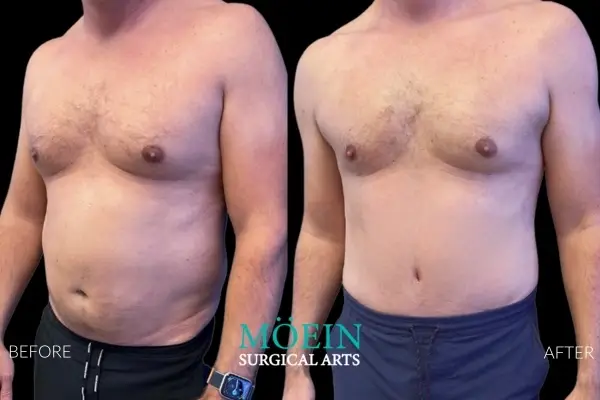
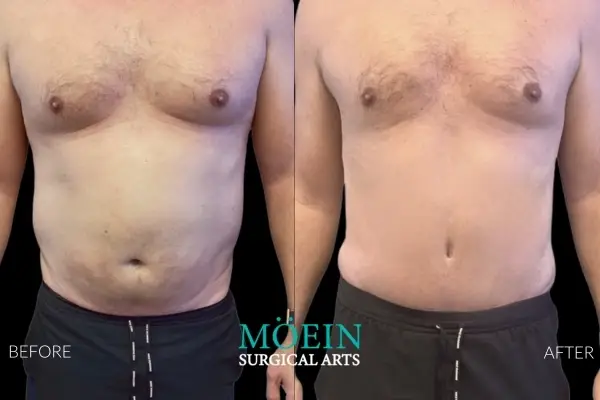
A male tummy tuck delivers both aesthetic and functional improvements:
⦁ Tighten Loose Skin: Eliminate sagging and wrinkling post–weight loss
⦁ Remove Stubborn Fat: Directly extract fat cells that resist diet and exercise
⦁ Repair Weakened Muscles: Reconnect and tighten separated rectus muscles for core strength
⦁ Improve Posture: Correct spinal alignment by removing excess weight off the front of the body
⦁ Enhance Athletic Contour: Achieve a ⦁ defined, six-pack appearance with abdominal etching
⦁ Boost Confidence: Restore comfort in clothing, gym sessions, and social settings
Beyond cosmetic gains, many men report reduced back pain and improved core stability after muscle repair and fat removal. By addressing both form and function, a tummy tuck can transform physical comfort as well as self-image.
Who Is an Ideal Candidate for Male Abdominoplasty?
One of the most asked questions men ask is if they are a good candidate for tummy tuck. You may be a strong candidate if you:
⦁ Maintain a stable weight and healthy lifestyle
⦁ Are in ⦁ good overall health⦁ with no untreated conditions
⦁ Have realistic expectations about outcomes and recovery
⦁ Do not smoke can quit at least 6 weeks before surgery
⦁ Experience loose skin or muscle separation (diastasis recti)
⦁ Struggle with stubborn fat pockets despite diet and exercise
Men who undergo significant weight loss, whether through lifestyle changes or bariatric surgery,often find that excess, hanging skin detracts from their results. A tummy tuck removes this redundant tissue and tightens the abdominal wall, allowing your physique to reflect the effort you’ve invested.
Even if you’re uncertain, a consultation with Dr. Moein will clarify your goals and determine if abdominoplasty, supplemental VASER liposuction, or a combination approach is best for you.
The Male Tummy Tuck Procedure: What to Expect
Preparing for a male tummy tuck involves several straightforward steps: each phase, from your comprehensive consultation and pre-operative assessments to the surgical plan and post-operative support, is designed to optimize your results while ensuring your comfort and safety.
⦁ Consultation & Evaluation: Review medical history, exam of abdominal anatomy, and discussion of goals
⦁ Surgical Plan: Selection of mini, full, extended, or circumferential abdominoplasty
⦁ Anesthesia: Typically, general anesthesia, with options for long-acting local blocks
⦁ Incision & Muscle Repair: Detach and tighten the abdominal muscles (plication)
⦁ Skin & Fat Removal: Excise excess tissue; perform targeted liposuction for smooth contour
⦁ Closure & Drainage: Place drains if needed and close incisions with aesthetic suturing
Each step is designed to minimize complications and optimize healing. Dr. Moein uses microcannulas for needed fat removal and gentle tissue handling to reduce swelling and speed recovery.
Following surgery, patients typically wear a compression garment to support the abdomen and reduce fluid buildup. Our accredited surgical center in Beverly Hills ensures the highest safety standards and comfort throughout your procedure.
Recovery and Aftercare: Getting Back to Your Routine
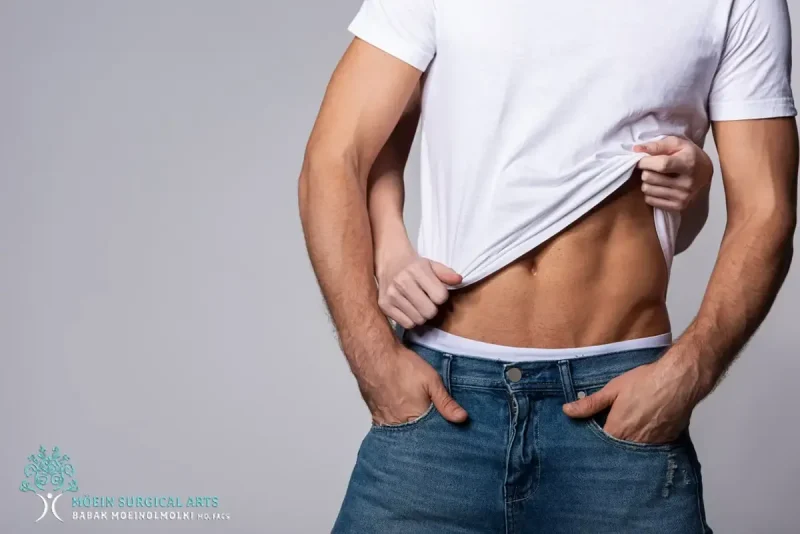
Recovery timelines can vary, but most men experience manageable discomfort that peaks within the first few days—our tailored pain management protocols help keep you comfortable so you can focus on healing. We understand your top concern is returning to work, workouts, and family life as quickly and safely as possible; that’s why our team provides clear milestones and support every step of the way.
⦁ Work Return: 7–10 days for desk jobs; light activity permitted earlier
⦁ Exercise Resumption: Avoid strenuous core workouts for 4–6 weeks; walking is encouraged
⦁ Garment Usage: Wear compression wraps or a binder for 4–6 weeks to control swelling
⦁ Follow-Up Visits: Scheduled at 2 days, 1 week, 1 month, 3 months, 6 months and 1 year
⦁ Scar Care: Apply silicone or topical treatments to promote optimal healing
Initial discomfort managed with prescription medications peaks around day 2–3, then subsides significantly. By 2–4 weeks, most swelling has resolved, revealing a flatter, firmer abdomen. Full maturation of scars and final contour can take up to one year. Patient testimonials often describe the experience as surprisingly manageable, with many returning to daily life almost immediately and feeling more confident with each passing day.
Cost of Male Tummy Tuck in Los Angeles
Understanding investment in your transformation is key: we believe in transparent pricing, so you’ll receive a comprehensive breakdown of all costs from surgeon’s fees and facility charges to anesthesia and post-operative care. This approach ensures you can plan your journey with complete confidence.
LA Area Total Cost: Typically ranges from $10,000 to $18,000 depending on the type of tummy tuck. At Moein Surgical Arts your quote includes surgeon’s fee, anesthesia and facility as well as in-depth consultation, pre and post op appointments for one year.
Variables Impacting Price:
⦁ Surgeon’s expertise and board-certification
⦁ Type of tummy tuck (mini, full with or without plication, extended)
⦁ Geographic location and facility fees
⦁ Addition of liposuction, muscle etching or other procedures
Most health plans do not cover cosmetic abdominoplasty, but financing options are available. Potentially, if you have a hernia repair, part of your surgery may be covered. During your consultation, we’ll review transparent pricing and tailor a plan that aligns with your goals and budget
Why Choose Dr. Babak Moein for Your Male Tummy Tuck?

Selecting the right surgeon is the most important step on your journey to a firmer, more defined midsection. Dr. Babak Moein combines decades of specialized training, artistic precision, and a patient-first philosophy to ensure your male tummy tuck delivers natural, athletic contours—and an experience that feels as personal as it does professional.
With every procedure tailored to your unique anatomy and goals, you’ll benefit from world-class safety standards, a hospital-style surgical suite, cutting-edge techniques, and comprehensive support from consultation through recovery. Dr. Moein offers:
⦁ Double Board-Certification: Expertise in both cosmetic and weight-related surgery
⦁ Customized Approach: Procedures designed for masculine anatomy and athletic definition
⦁ Safety First: Accredited surgical center with advanced monitoring and post-op care
⦁ Proven Results: Natural-looking transformations that restore confidence and comfort
⦁ Comprehensive Support: Pre- and post-surgical guidance, from garment fitting to scar management
⦁ Several Financing Options: Moein Surgical Arts has a relationship with several companies that offer financing for a range of credit ratings
Dr. Moein’s commitment to personalized care ensures that every male tummy tuck patient feels heard, respected, and empowered throughout their journey.
Take the Next Step: Schedule Your Consultation
Ready to achieve the flat, firm core you deserve? Not ready to have a “Dad or Mom bod”? Book your private consultation with Dr. Babak Moein at Moein Surgical Arts today.
You can also call once of our appointment coordinators M-F 8 am to 8 pm | Saturday and Sunday from 10 am to 3 pm. We offer a few complimentary virtual appointments each week. Reserve yours today at 301-455-8020.
Discover how a male tummy tuck can unlock greater confidence, improved posture, and a physique that matches your hard-earned dedication.
]]>Removing breast implants can be a profoundly personal decision. For some women, it’s driven by discomfort, health concerns, or complications. For others, it reflects a change in lifestyle, evolving self-image, or simply a desire to feel more authentic in their bodies.
But no matter the reason, many women are surprised by the emotional impact of seeing a flat chest after implant removal.
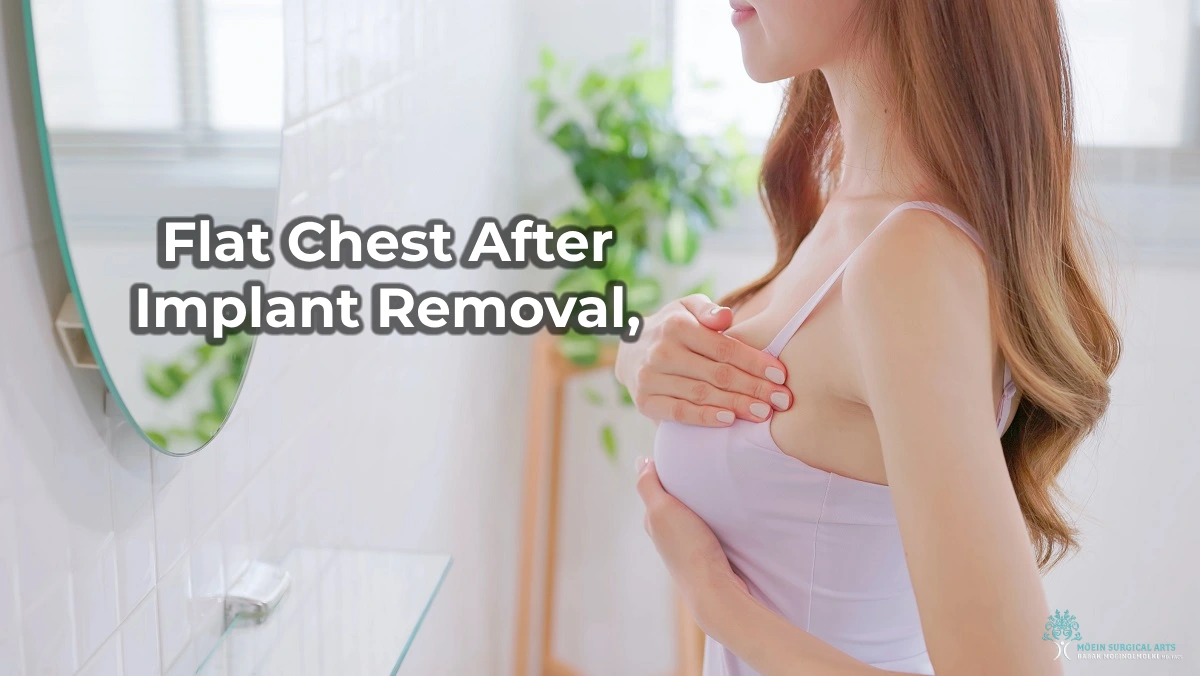
It’s not just about having smaller breasts; the tissue may appear deflated, nipples can point downward, and the skin might not snap back the way you’d hoped. You may look in the mirror and think, “This isn’t me either.”
If you’re struggling with a flat chest after implant removal, know that you are not alone, and more importantly, this isn’t the end of your story. It’s the beginning of a new chapter, one where you get to choose how you feel and look moving forward.
Whether you’re considering a breast lift, fat grafting, or want to explore your options, solutions exist to help restore your confidence and contour. You deserve to feel good in your body again.
Table of Contents
Why Women Are Saying Goodbye to Implants
There isn’t one reason women remove their implants. Instead, it’s often a mix of physical discomfort and emotional clarity.
Some women have battled complications like capsular contracture or breast implant illness (BII). Others are just tired of the upkeep, of living in a body that no longer matches who they are today. The idea of more surgery to replace implants doesn’t sit right anymore.
And sometimes, it’s as simple as wanting softness. Subtlety. A return to a more natural look.
Take Natalie, 46. She had implants for nearly two decades, but over the years, they felt more like armor than confidence. She planned to replace them, until her consultation. “I realized I wasn’t trying to be my 30-year-old self anymore,” she said. “I just wanted to feel like me.”
Natalie opted for implant removal with a breast lift and fat transfer. Now she wears soft camisoles, goes braless on weekends, and says she feels “light again.”
What To Expect After Implant Removal?
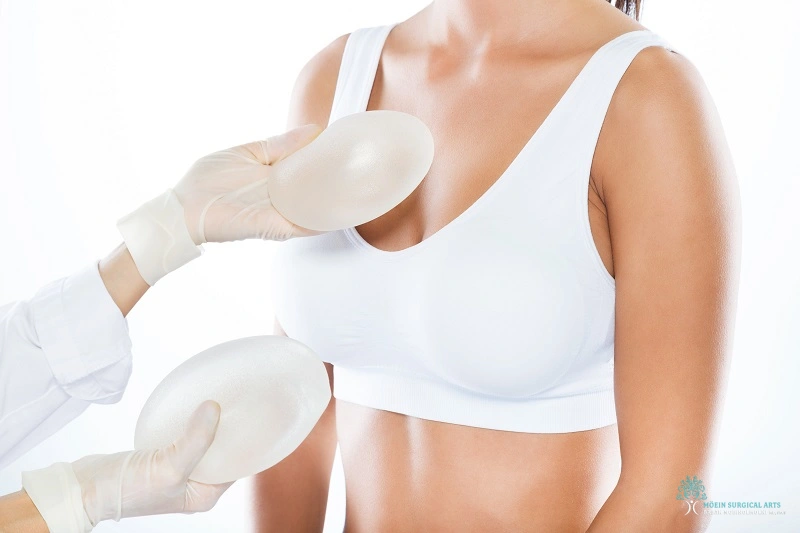
No sugarcoating it: removing implants can leave your breasts looking flat or deflated, especially if the implants were large or had been in place for a long time.
You might notice:
⦁ A hollow or sunken upper chest
⦁ Looser skin with a little sag or droop
⦁ Nipples sitting lower than you remember
⦁ A smaller silhouette that doesn’t feel balanced
This can feel unfamiliar, even jarring. But it doesn’t mean you have to live with it. Many women go on to feel more comfortable and attractive after explant than they ever did with implants. The key is choosing the right follow-up.
The Next Step: What Are My Options?
The Next Step: What Are My Options?
Explant surgery is just part of the journey. There are several ways to restore your shape and confidence without returning to implants.
A Breast Lift: Redefining the Silhouette
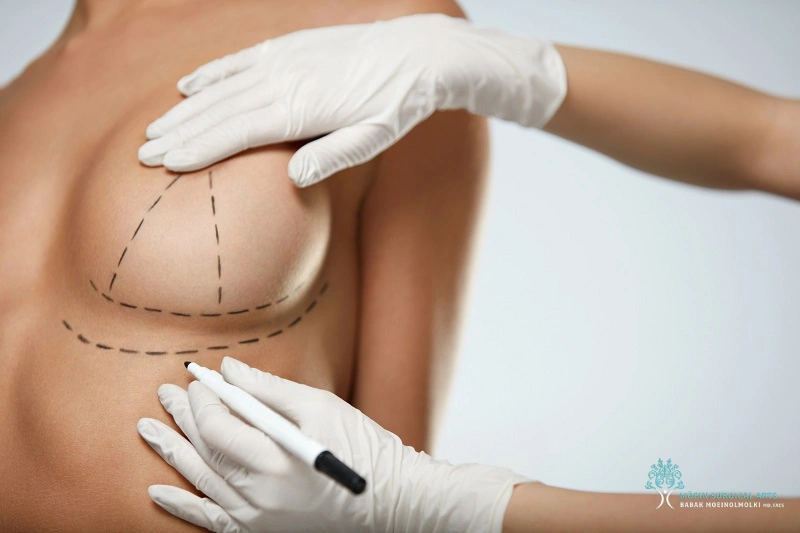
A breast lift (mastopexy) reshapes the natural breast tissue, trims excess skin, and repositions the nipples. It’s ideal if your skin has stretched or your breasts now feel empty or low.
Who it helps:
⦁ Women with sagging or drooping after implant removal
⦁ Nipples pointing downward or sitting below the crease
⦁ Patients who want a firmer, more youthful shape
Rachel, 52, had a breast lift after removing her implants due to capsular contracture. “I thought I’d look like a deflated balloon,” she admitted. “But after the lift, I looked in the mirror and saw me again. Not 25-year-old me. Better.”
Fat Transfer: Soft, Natural Volume
For women who want to restore some fullness without going back to implants, fat transfer is an incredible option.
It involves gently removing fat from another area (like your abdomen or thighs), processing it, and injecting it into the breast to restore volume, usually about half to a full cup size.
Why women love it:
⦁ It’s 100% natural (your own fat)
⦁ It provides subtle lift and shape
⦁ It avoids foreign objects in the body
⦁ There’s a bonus of body sculpting where the fat is taken
The results are soft, authentic, and often feel more “you” than implants ever did.
Do Nothing: Choosing the Natural Path
And sometimes, the most empowering decision is to let your body be. Some women embrace their smaller breasts, scars, and all, as a sign of growth and authenticity.
That doesn’t mean going it alone. We support you with scar treatment, non-surgical skin firming options, and check-ins to help you feel strong and informed.
New Implants with a Lift: A Refined Refresh
If you’re not ready to go natural, some women choose to downsize their implants and add a lift for a better proportion and shape. It’s not about going back, it’s about choosing better for where you are now.
Fat Transfer Recovery and Results: What It Feels Like
The fat transfer process is gentle but requires skill and patience.
It begins with liposuction of the donor area, usually the abdomen or love handles. The fat is then purified and reinjected with precision into the breasts.
You might feel:
⦁ Soreness at the liposuction and injection sites
⦁ Swelling that settles over a few weeks
⦁ Results beginning to take shape in 2-3 months
Dr. Moein uses techniques that protect the fat cells for better survival and beautiful, even volume.
Results are long-lasting, though some of the fat will naturally be absorbed. What stays? Yours, forever.
When Is a Breast Lift the Right Choice?

We often hear, “How do I know if I need a lift?”
Here’s a quick check:
⦁ Your nipples point downward or fall below the breast fold
⦁ The skin feels loose or stretched
⦁ You have noticeable sagging after removal
Dr. Moein will walk you through a personalized evaluation. Some women need only a subtle lift; others benefit from combining it with fat transfer for both shape and fullness.
The goal isn’t just perkier breasts, it’s a shape that makes you feel like yourself again.
A More Human Approach: Let’s Talk About You
You’re not just another patient or a before-and-after photo.
Dr. Babak Moein, double board-certified in cosmetic and general surgery, sees women who are ready to reclaim their bodies—not because they want to be someone new, but because they want to come home to themselves.
This isn’t about trends. It’s about you:
⦁ Wanting to wear a white tee without feeling like people stare
⦁ Wanting to look good in your skin, not just your clothes
⦁ Wanting to move forward in your life with lightness and confidence
Dr. Moein specializes in explant surgery, breast lift, and natural breast enhancement. He’s known for his warmth, honesty, and artistry. You’ll feel heard. You’ll feel understood. And most importantly, you’ll have a plan.
Flat Chest After Implant Removal: Consult with Dr. Moein in Los Angeles, CA
Flat does not need to be your future.
There are beautiful, natural, life-enhancing paths forward, and they all start with a personalized conversation.
Schedule your private consultation with Dr. Moein today to discuss your options.
Zero pressure. Just clarity and next steps.
Call Now or Book Online to begin your journey.
Aging is a natural part of life, but for many, the visible signs, like sagging skin, deep creases, and loss of jawline definition, can impact self-confidence. Fortunately, advancements in cosmetic surgery offer powerful yet subtle solutions. One such option is the mini facelift, an increasingly popular choice for those experiencing the first signs of aging but not yet ready for a full facelift.
Table of Contents
What Is a Mini Facelift?

A mini facelift is a minimally invasive surgical procedure that addresses sagging in the lower third of the face, particularly the jawline, jowls, and upper neck. Unlike a traditional facelift, which often involves extensive dissection and recovery, the mini facelift uses smaller incisions (usually around the ears) to gently tighten skin and underlying muscles. This technique produces noticeable, natural-looking rejuvenation with fewer risks and quicker recovery.
Why Mini Facelifts Are Gaining Popularity
With today’s busy lifestyles, patients are seeking solutions that provide maximum results with minimal downtime. A mini facelift fits perfectly into this demand. Patients are drawn to:
- Shorter recovery times, often returning to normal activities in about a week
- Smaller, hidden incisions, reducing visible scarring
- Refined results that enhance rather than drastically alter appearance
- Affordability, as it often costs less than a traditional facelift
It’s a great option for individuals in their late 30s to 50s who want to look refreshed without the intensity of a full surgical transformation.
Difference Between Mini and Full Facelifts
| Feature | Mini Facelift | Full Facelift |
|---|---|---|
| Target Areas | Lower third of the face (jawline, jowls) | Entire face (cheeks, jawline, neck) |
| Incision Size | Smaller incisions around the ears | Longer incisions, often around ears and hairline |
| Anesthesia | Local anesthesia with sedation | Usually general anesthesia |
| Procedure Time | 1 to 2 hours | 2 to 5 hours |
| Recovery Time | 5 to 10 days | 2 to 3 weeks |
| Scarring | Minimal, hidden in natural creases | More extensive, but placed discreetly |
| Longevity of Results | 5 to 7 years | 8 to 10+ years |
| Best Candidates | Patients with mild to moderate aging | Patients with advanced signs of aging |
| Downtime | Shorter | Longer |
| Cost | Lower | Higher |
Who Typically Seeks This Procedure
People who typically seek a mini facelift are in their late 30s to early 50s and are beginning to notice mild to moderate sagging around the jawline and lower face. These individuals often want subtle, natural-looking improvements without the downtime of a full facelift. They’re usually looking for a refreshed appearance rather than dramatic changes and prefer less invasive options with quicker recovery.
Facial Aging and the Need for Intervention
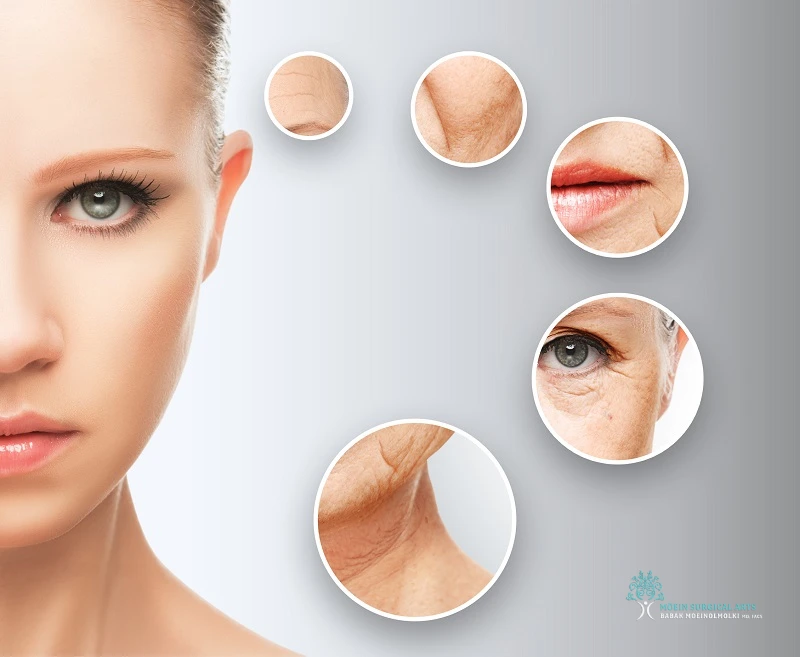
How Aging Affects the Lower Face
Over time, skin loses elasticity, and facial fat shifts downward, resulting in jowls, marionette lines, and a blurry jawline.
Role of Genetics, Skin Type, and Lifestyle
Genetics play a big role in how early or dramatically these changes occur. Factors like sun exposure, smoking, and stress can speed up the process.
Signs You Might Benefit from a Mini Facelift
- Early jowling or sagging cheeks
- Nasolabial folds becoming more prominent
- You look tired or older than you feel
Non-Surgical Alternatives vs. Surgical Solutions
Fillers and Botox can help to an extent, but when laxity becomes too severe, a mini facelift offers longer-lasting, structural rejuvenation.
How a Mini Facelift Works
Overview of the Procedure
A mini facelift is a refined cosmetic procedure designed for patients seeking facial rejuvenation with less downtime. It is usually performed under local anesthesia combined with sedation, which allows the patient to remain comfortable while avoiding the risks and recovery associated with general anesthesia. The procedure typically lasts 2 to 3 hours, depending on the complexity and individual anatomy. During this time, targeted lifting and tightening are performed to refresh the lower face and jawline without the need for more extensive surgical intervention.
Strategic Incisions in Mini Facelifts for Natural Results
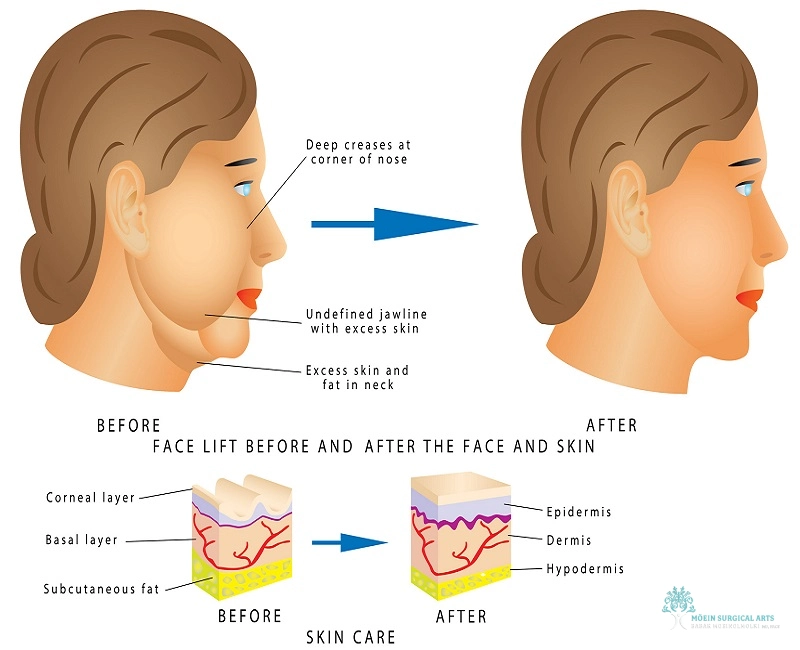
To begin the procedure, small, discreet incisions are placed around the natural contours of the ear and sometimes along the temporal hairline. These incision locations are chosen specifically to provide optimal access to the SMAS layer (Superficial Musculoaponeurotic System) while ensuring that visible scarring is minimized. The incisions enable the surgeon to elevate and reposition the underlying tissues, rather than just tightening the skin, which is crucial for achieving natural-looking and longer-lasting results.
Lifting the SMAS Layer for Lasting Results
The SMAS layer, a fibrous network beneath the skin, plays a crucial role in facial structure and aging. During a mini facelift, this layer is carefully lifted and tightened, providing structural support that enhances facial definition, reduces sagging, and smooths out early jowls. This deep-plane adjustment ensures that results are not only subtle and natural, but also durable, often lasting 5 to 7 years or more, depending on skin quality and lifestyle factors.
How the Procedure Minimizes Scarring
One of the significant benefits of a mini facelift is the minimal and well-concealed scarring. The incisions are placed in natural creases, such as the fold in front of and behind the ear, and within the hairline, making them nearly invisible once healed. Furthermore, because the procedure involves less skin removal and reduced trauma to surrounding tissues, patients typically experience faster healing and less noticeable scars compared to traditional facelift techniques. Over time, most patients report that the scars fade to the point of being virtually undetectable.
Benefits of a Mini Facelift
Shorter Recovery Time
One of the most appealing advantages of a mini facelift is the reduced downtime. Most patients are able to return to work, social events, and light physical activity within 7 to 10 days. This shorter recovery window is due to the less invasive nature of the procedure, which involves smaller incisions and limited tissue disruption. Postoperative swelling and bruising are typically milder than with a full facelift, making the mini facelift an ideal option for individuals with busy lifestyles who want noticeable improvement without an extended healing period.
More Subtle, Natural-Looking Results
Rather than dramatically altering your appearance, a mini facelift is designed to restore a youthful version of your natural self. By focusing on the lower third of the face, particularly the jawline and early jowling, it provides a gentle lift that smooths the skin and improves definition. The results are refined and discreet, avoiding the “overdone” or pulled-tight appearance that can sometimes occur with more aggressive procedures. This makes the mini facelift a popular choice for patients who desire age-appropriate rejuvenation without appearing as though they’ve undergone surgery.
Lower Risk of Complications
Because the mini facelift is a more conservative procedure compared to a full facelift, the risk of surgical complications is significantly lower. With reduced operating time, smaller incisions, and minimal tissue manipulation, there is a decreased likelihood of infection, hematoma, nerve injury, or excessive scarring. The use of local anesthesia with sedation also eliminates the risks associated with general anesthesia, further improving safety and patient comfort.
Can Be Combined with Other Treatments

For those looking to achieve more comprehensive facial rejuvenation, a mini facelift can be safely and effectively combined with other cosmetic procedures. Common adjunctive treatments include:
- Neck Liposuction: Removing excess fat from under the chin and neck enhances jawline definition and complements the lifting effects of the mini facelift.
- Blepharoplasty (Eyelid Surgery): Addressing drooping upper lids or puffy under-eyes can further refresh the overall facial appearance, making the eyes look brighter and more awake.
- Non-Surgical Enhancements: Dermal fillers, skin resurfacing, or neurotoxins like Botox can be incorporated for added refinement, volume restoration, or smoothing of fine lines.
These combination treatments allow for personalized results tailored to the patient’s unique aging pattern and aesthetic goals, often performed in a single surgical session for added convenience.
What to Expect During Recovery
Post-Surgery Timeline (Days 1 to 14)
- Days 1-3: Swelling and mild discomfort
- Days 4-7: Stitches removed, bruising begins to fade
- Days 8-14: Return to light activities
Pain Management and Bruising Expectations
Most patients report only mild pain, easily managed with oral medications. Bruising and swelling typically peak around day 3.
When You Can Return to Work or Social Activities
Light office work can resume in about a week. Avoid intense exercise or heavy lifting for 2-3 weeks.
Long-Term Maintenance Tips
- Use sunscreen daily
- Maintain a stable weight
- Consider annual skincare treatments to boost results
Why Choose Dr. Moein for Your Mini Facelift in Los Angeles
Dual Board-Certified Expertise
Dr. Moein is board-certified in both cosmetic and general surgery, offering a unique skill set for safety and aesthetics.
Artistic Eye Meets Surgical Precision
He balances precision with an artistic approach, ensuring your results look natural, not overdone.
Customized Approach for Each Patient
Every mini facelift is tailored to your unique facial anatomy and goals.
Real Patient Testimonials and Before/After Photos
Dr. Moein’s patients consistently report increased confidence and satisfaction. See transformations on the before-and-after gallery.
Next Steps: Your Mini Facelift Consultation
How to Schedule
Ready to refresh your look?
What to Expect During Your First Visit
Dr. Moein will evaluate your facial structure, listen to your goals, and recommend a customized plan.
Questions to Ask During Consultation
- Am I a good candidate?
- What are realistic results for me?
- Will I need any complementary treatments?
Financing and Recovery Planning
Flexible financing is available. Our team will guide you through what to expect during recovery.
 Call us at (310) 455-8020
Call us at (310) 455-8020 Request Your Consultation Online
Request Your Consultation Online
Let Dr. Moein help you look as young as you feel, naturally and beautifully.
]]>At Moein Surgical Arts in Los Angeles, Dr. Babak Moein sees many patients who want to reshape their bodies with liposuction but want it done right the first time.
The cost of liposuction isn’t just what you pay upfront; it’s how you feel about your results long after surgery.
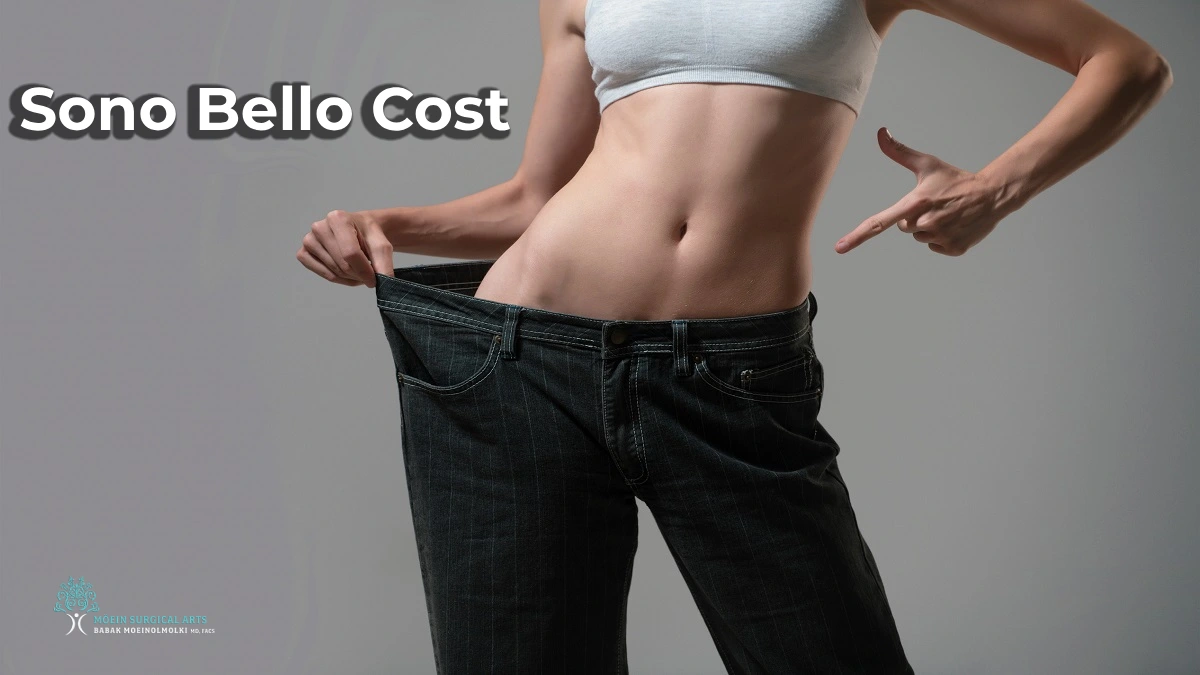
Table of Contents
Why Sono Bello Cost Appeals to So Many?
Sono Bello has become a recognizable name in cosmetic surgery. It’s a large, nationwide chain that markets body contouring, primarily liposuction, at seemingly accessible prices with quick turnaround times.
The average cost for a Sono Bello procedure typically ranges from $1,000 to $1,500 per area, depending on the city and the size of the area treated. These numbers can seem attractive, especially for those looking for a fast fix to stubborn fat.
But when you’re investing in something as personal and visible as your body, speed and price shouldn’t be the only considerations. And when pricing for superior VASER liposuction is competitive, why take a chance?
Mass-Market Surgery vs. Personalized Aesthetics
Dr. Moein offers a different approach, one that centers around customization, artistry, and long-term satisfaction. While mass-market options often employ standard suction techniques, Dr. Moein utilizes VASER liposuction, an advanced ultrasound-assisted technology that targets fat more precisely and promotes smoother, firmer skin.
Here’s how it compares:
| Feature | Sono Bello | Dr. Moein – VASER Lipo |
|---|---|---|
| Technique | Traditional Liposuction | Ultrasound-Assisted VASER |
| Surgeon Availability | Varies by location | One Dedicated, Dual Board-Certified Surgeon |
| Artistic Customization | Limited | High – Tailored Body Sculpting |
| Skin Tightening Support | Not Included | VASER Lipo Has Skin Tightening Properties and is Frequently Combined with Renuvion |
| Risk of Uneven Results | Reported by Some Patients | Significantly Lower with VASER |
| Revision Likelihood | Higher with Basic Lipo | Lower due to precision + technology + experience |
Why Body Contouring Customization Matters at Every Age and Sex?
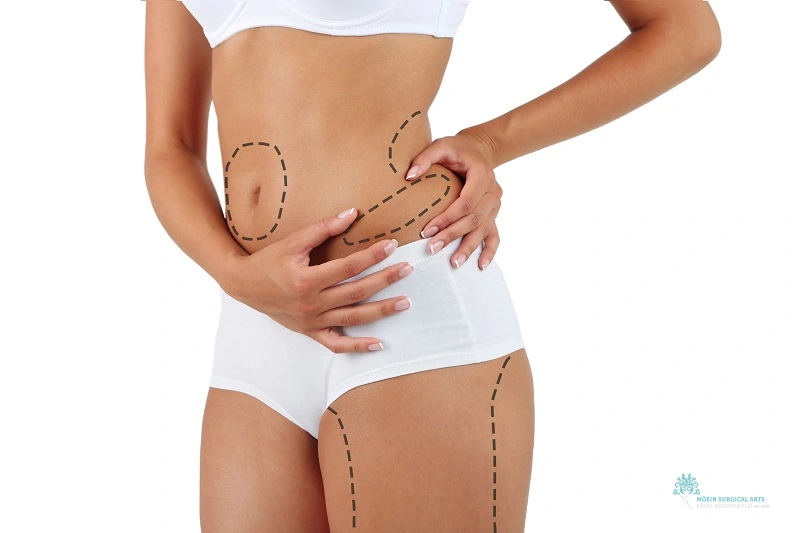
Different ages require different body contouring strategies. One-size-fits-all doesn’t apply when it comes to liposuction. At Moein Surgical Arts, Dr. Moein considers age, skin elasticity, lifestyle, and goals when planning each procedure.
- In your 20s: Many young women want to perfect areas like the waist or thighs with clean, defined contours. VASER allows for precise sculpting without disrupting surrounding tissues.
- In your 30s: After having children or experiencing body changes, moms want to restore or even improve their pre-baby shape. Combining VASER with skin-tightening techniques ensures results look natural, not deflated or saggy.
- In Your 40s and Beyond: Skin starts to lose elasticity, and older techniques can leave behind loose skin. VASER can be paired with Renuvion to lift and firm, delivering youthful, smooth results.
- For Men: Love handles, belly fat, and chest fullness can be tough to target with diet alone. VASER helps define muscle structure underneath while removing stubborn fat, without looking “done.”
No matter your age or gender, your body has its own story, and it deserves a personalized approach. At Moein Surgical Arts, Dr. Moein tailors every treatment to enhance what makes you unique, using advanced tools like VASER to deliver refined, natural-looking results.
Because when it comes to body contouring, customization isn’t a luxury, it’s the key to confidence that lasts.
Why Surgical Skill Matters More Than Sono Bello Cost in Liposuction Results?
Liposuction isn’t just about removing fat; it’s about sculpting the body. That’s where the surgeon’s experience and eye for detail make all the difference.
Dr. Moein is one of the few surgeons in the U.S. who is dual board-certified in both cosmetic and bariatric surgery. That means he’s not only highly trained in fat removal but also understands how the entire body should look and function. His results reflect symmetry, proportion, and harmony, not just smaller sizes. He stands out as one of the few cosmetic surgeons with extensive experience in treating patients with higher BMIs.
Patients frequently choose Dr. Moein after seeing the difference in before-and-after photos of others who had their procedures done at high-volume clinics. He understands that a great result isn’t about how fast fat is removed, but how well the body is shaped afterward.
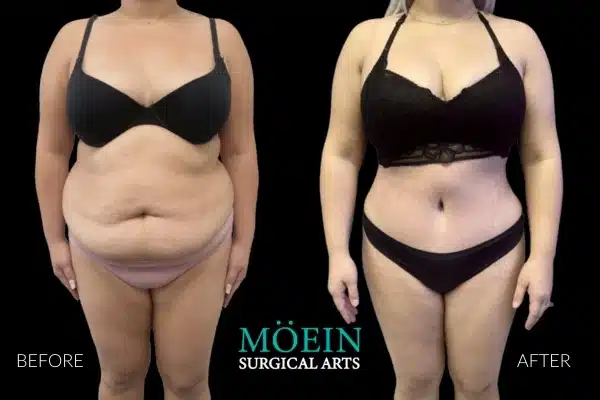

Are you beginning to see how Sono Bello cost is not necessary the only criteria or even the value it appears to be on the surface.
Does Sono Bello Cost Include Fat Harvesting?
One common question patients have when comparing liposuction providers is whether the cost includes fat harvesting, the process of collecting and preserving fat cells for potential transfer to other areas like the buttocks, breasts, or face. If you’re thinking ahead about enhancing your shape with your own natural fat, this is an important consideration.
At Sono Bello, fat is typically only removed using a basic laser-assisted liposuction technique. While this method can be effective for removing fat, the use of laser heat often damages the fat cells, making them unsuitable for fat transfer procedures. In most cases, the harvested fat is discarded, and there is no preservation process for reinjection into other areas of the body.
That means:
No fat transfer to the buttocks (BBL-style procedures)
No volume enhancement to the face or breasts
No opportunity to repurpose your own tissue for sculpting
In contrast, Dr. Babak Moein uses VASER liposuction, which gently breaks up fat using ultrasound energy, preserving the integrity of fat cells and making them ideal for fat transfer. This allows patients at Moein Surgical Arts to take full advantage of their procedure by enhancing multiple areas in a single session.
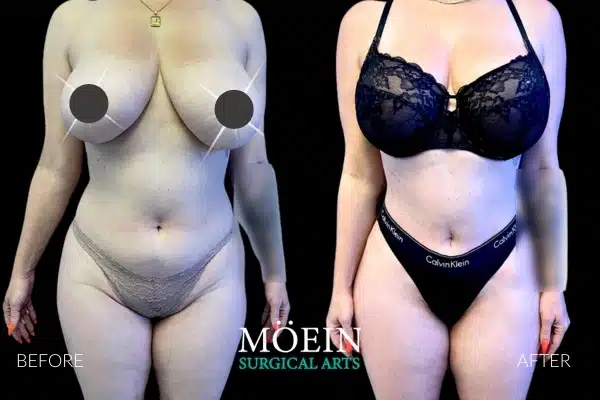
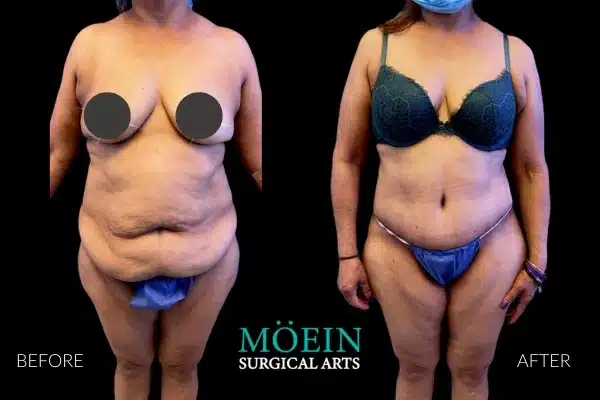
So, while Sono Bello’s pricing might seem simpler upfront, it’s important to ask what’s actually included and what possibilities are left off the table
The Hidden Cost of “Redo” Surgery
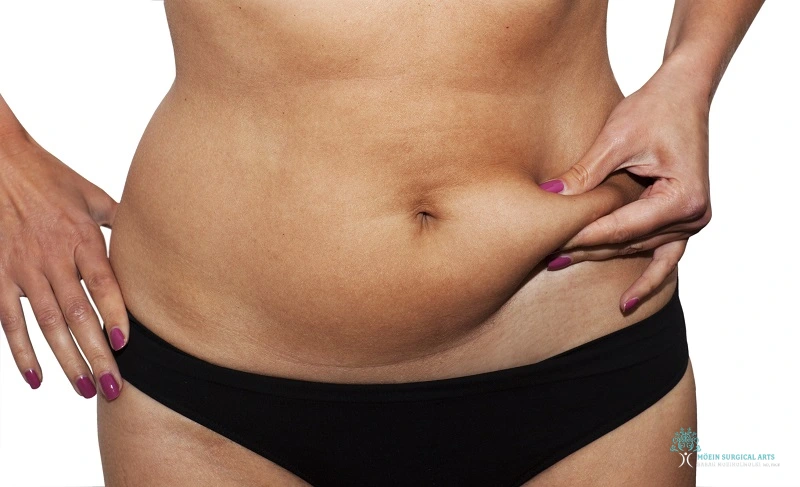
It’s true that Sono Bello and similar clinics can seem like a budget-friendly option upfront. But the most expensive liposuction is often the one you have to do again.
Patients come to Dr. Moein to revise previous surgeries that left them with:
- Lumpy or uneven fat pockets
- Loose skin that wasn’t addressed
- Disappointing or unnatural-looking shapes
Revision surgery is not only more complex, it’s often more expensive and emotionally draining than doing it right the first time.
Why Los Angeles Patients Trust Dr. Moein?
As a surgeon practicing in one of the most body-conscious cities in the world, Dr. Moein understands the importance of confidence and discretion. His focus is not only on removing fat but also on delivering elegant, natural, and lasting results through advanced tools and refined techniques.
He personally performs every consultation and procedure. No guesswork. No handoffs. Just expert care tailored to your body, goals, and future.
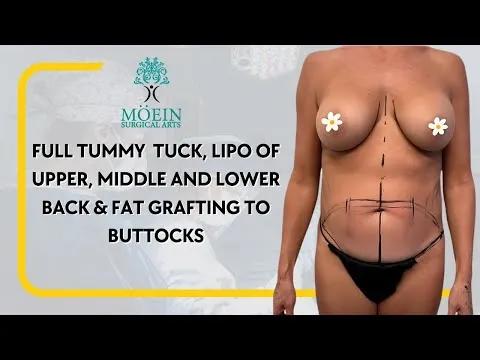
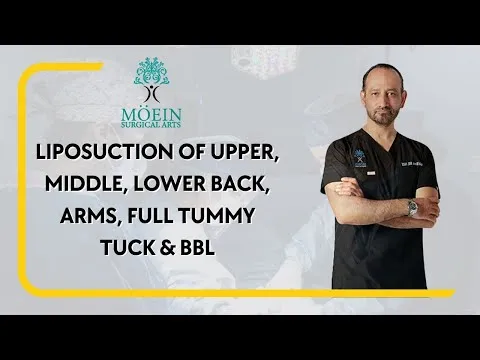
Final Thoughts: Sono Bello Cost vs. Value – Is More Than a Number
Searching “Sono Bello cost” is a smart move you’re doing your homework. But as you compare options, remember that cost isn’t just what you pay today. It’s also what you may pay tomorrow if you’re unhappy with the results.
Dr. Moein believes your body deserves more than a cookie-cutter solution. It deserves an artist’s eye, a surgeon’s precision, and a result that makes you feel confident for years to come.
Our Liposuction Cost in Los Angeles guide provides a more detailed breakdown of pricing, typical range by area, factors that influence fees, and available financing options for patients. In it, Dr. Moein describes how technique, BMI, number of treatment areas, and the need for skin tightening all impact the final investment, so you can compare mass-market quotes with a fully customized VASER liposuction plan performed by a dual board-certified surgeon.
Pricing FAQs
1-Does Sono Bello Offer Financing and Payment Plans?
Yes, Sono Bello provides financing through third-party lenders, such as CareCredit, that may allow qualified patients to pay with low monthly installments rather than one large sum.
Approval, interest rate, and the length of a payment plan depend on your credit profile and the total cost of your procedure.
2- Does insurance cover Sono Bello procedures?
As the treatments that Sono Bello provides are elective cosmetic procedures, health insurance plans generally do not cover their cost. Most patients pay for these procedures out-of-pocket but have financing options with the clinic to make monthly payments more manageable.
Your Next Step: Discover the Right Path for You
Ready to learn what’s possible with a truly customized approach to liposuction?
Book a private consultation with Dr. Babak Moein at Moein Surgical Arts in Los Angeles
Get a body analysis tailored to your goals and your anatomy
See what advanced VASER and skin-tightening techniques can do, even if you’ve had liposuction before.
Learn if you’re a candidate for skin tightening add-ons
Stop wondering. Start transforming
Conveniently located in Los Angeles in the Beverly Hills area.
Call (310)-455-8020 or click here to request your personalized consultation today.
Because this time, you deserve to love the result.


